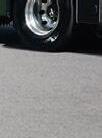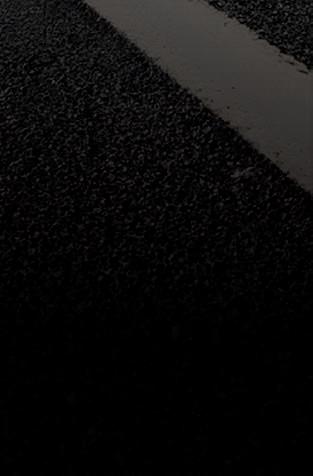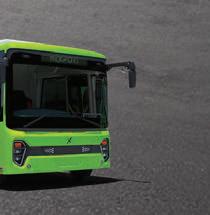

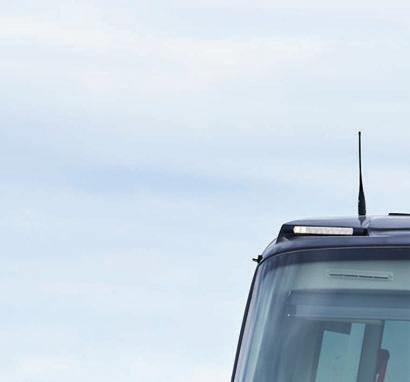

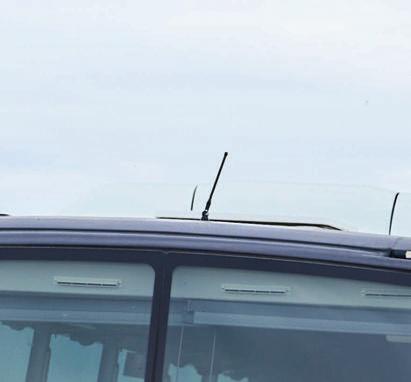

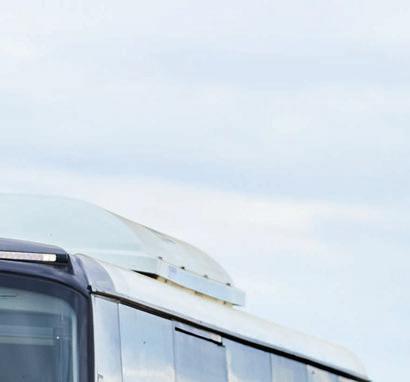


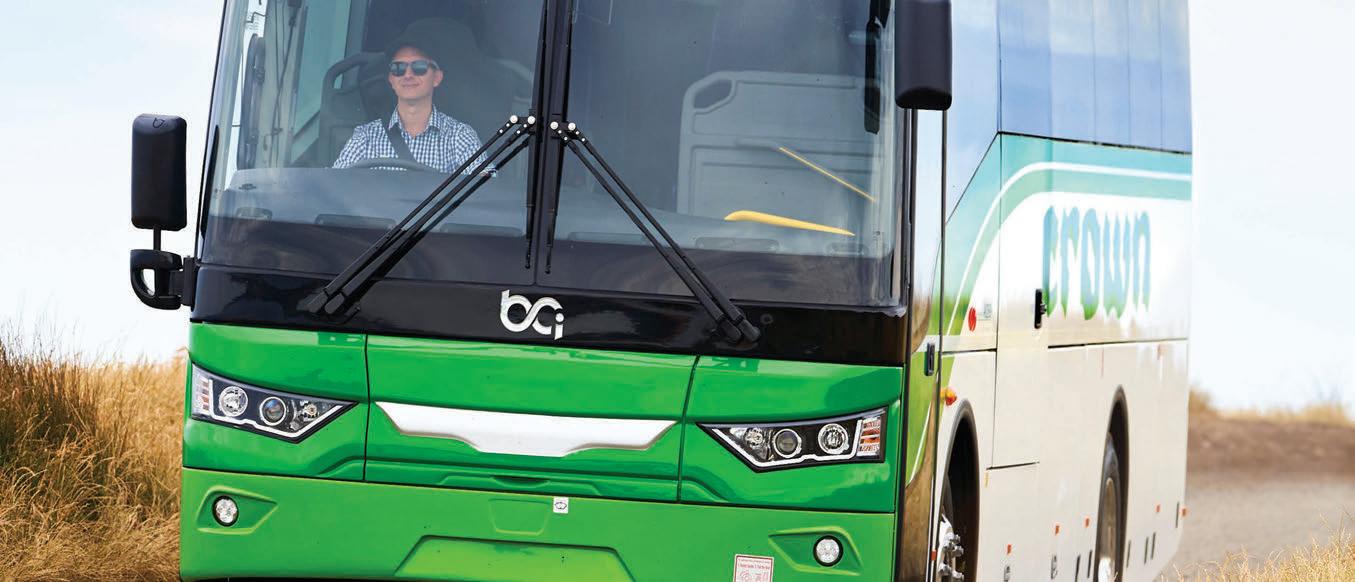



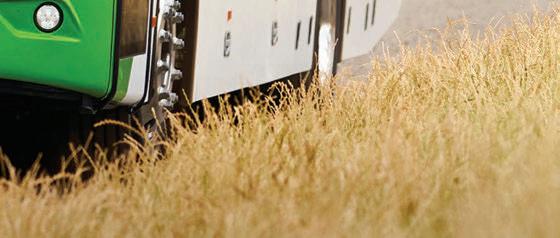

















BCI IS LEADING AN ELECTRIC REVOLUTION WITH CROWN COACHES




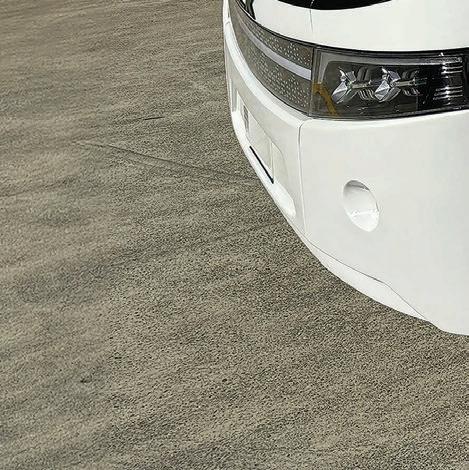






























The current state of play for Australasia’s bus and coach operators is changing before our very eyes, with acquisitions becoming a sign of the times
Only a few years ago, the Australasian bus and coach industry was full of so many operators that it was borderline impossible to have a grasp of just how many businesses operated bus services around the region.
I remember when I first started on ABC in the early months of 2022 and began discovering new operators every working day, slowly piecing together the puzzle that encapsulates Australia’s unique bus and coach industry. In just over two years, the landscape has completely changed, with major operators being sold to multi-national giants and family businesses being bought up as a select few companies have tightened their grasp over certain metropolitan contract regions in Australia’s largest cities.
The trend isn’t just down to one operator – whether it be Ventura’s recently confirmed sale to Singapore’s Keppel Infrastructure Trust or the news in late May that Kinetic had expanded its presence in Tasmania once again with the acquisition of renowned Burnie-based family business Crawn Motors, these stories are happening more and more o en.
With contracts now hanging in the balance in key cities like Melbourne, the bus and coach operating scene in Australasia is condensing into a smaller pool of larger players.
For the operators that are still carrying on decades of rich history, innovation has been key. A key example is the partnership between Victorian operator Crown Coaches and supplier BCI that is represented on our cover.
Over a decade ago, Crown Coaches decided to dabble in sustainable bus technology with BCI. While it may not have initially been successful, the experience has paved the way for Crown Coaches’ recent order of BCI electric buses that have begun hitting Melbourne roads.
From page 18 onwards, the cover story typifies the direction that forward-think-
ing suppliers like BCI and their operator partners are veering towards.
Another example not far away from Crown Coaches and its new BCI fleet is the Dyson Group. For decades the family company has expanded its reach from its home in Melbourne’s north-east to regional centres towards the Victorian and New South Wales borders. Now, with a new corporate structure in place and a Shepparton regional hub under construction, its focus is turning towards zero-emissions buses, as can be seen from page 38.
The key issue holding operators back from following in Dysons’ footsteps is the lack of government direction on the zero-emissions transition. ABC dug deeper this month, putting questions around the slow ZEB uptake to major government transport bodies in Australia’s largest states to find out what is coming in the near future on page 22.
On the OEM side, bus technology is only improving, with BLK Auto refining its model range and reintroducing a popular variant of its President vehicle from page 27. VDI reflected on its quick evolution distributing Yutong buses in Australia on page 30, with more ZEB innovations on the way, while Bus Stop Sales’ leader Pete White discusses the dealer’s lessons from its ongoing sustainability focus on page 32.
With Volvo now evolving the way its sales staff sells ZEB models to local customers on page 38, brands like GoZero Group are building in the Australasian industry with their dedication to a complete zero-emissions solution. With finance parties such as Bus Finance Australia (from page 42) also coming to the party with modern and flexible infrastructure funds, the industry is doing all that it can to fasten the transition in Australasia.

Sean Mortell EDITOR, ABC


Yutong D7E electric bus zooms into the future without compromising on passenger comfort. This manoeuvrable marvel tackles city streets, schools, and even squeezes into tight corners on mine sites. Stepping aboard is effortless thanks to the D7E's lowered step, while the interior offers comfortable seating for 23-40 passengers. But don't be fooled by its size – the D7E prioritises safety above all else. Advanced driver-assistance systems keep everyone aware and protected, ensuring a smooth ride for every journey. Sustainable, Efficient, and Ready for Anything, the D7E is the future of smart transport.














4. editorial | new world
The current state of play for Australasia’s bus and coach operators is changing before our very eyes, with acquisitions becoming a sign of the times
8. news | all aboard
An overview of the latest Australasian and international bus and coach news that you need to know features
18. cover story | bci
A NEW CROWN
As a medium-sized family business, Crown Coaches is punching above its weight courtesy of a new electric bus partnership that extends its enduring bond with supplier BCI
22. feature | zeb transition PLUGGING IN
ABC chats to four states about how they’re juggling the infrastructure challenges involved with the zero-emissions change in the Australian bus and coach industry
27. feature | blk auto POPULAR RETURN
Amid a decision to streamline its fleet, BLK Auto has reinstated a former midi member of its President range
30. zeb infrastructure feature | vdi
ELECTRIFYING THE INDUSTRY
VDI Australia and Yutong have taken massive strides in introducing electric buses for Australian operators that suit local roads
32. zeb infrastructure feature | bus stop sales
ELECTRIC JOURNEY
For years, Bus Stop Sales has had its eye on introducing electric bus technology to Australia. Now, its partnership with King Long is allowing it to be at the forefront of sustainable change
35. zeb infrastructure feature | dyson group
REGIONAL INVESTMENT
Dyson Group’s latest regional hub will see it establish a zero-emissions home in one of the fastest growing towns in Victoria
38. zeb infrastructure feature | volvo TRUSTED PARTNER
Volvo Bus is leading the way locally for operators in the zero-emissions space
40. zeb infrastructure feature | gozero group FROM ZERO TO A THOUSAND
From its #GreenSchools1000 initiative aimed at rolling out 1000 electric school coaches to accreditation on TfNSW’s Bus Panel 4 and now partnering on the regional zero-emissions bus trials, GoZero Group is gaining pace
42. zeb infrastructure feature | bus finance australia ZERO EMISSIONS, ZERO WORRIES
A er recently establishing itself as an independent entity, Bus Finance Australia is using 20 years of history to provide new funding packages for zeroemissions vehicles and their infrastructure
44. zeb infrastructure feature | nz focus SUPPORT ZEBS
The NZ bus industry is leading the way in the nation’s net zero transition, but what else can be done to support this trend?
46. column | bca nz SHARING CHALLENGES
The BCA is already seeing a common ground between the Australian and New Zealand bus industries as it pushes for change
48. recap | bus sa conference BRINGING TOGETHER
Bus SA held another successful annual conference in May, bringing together the industry to discuss the biggest topics
51. competition | best bus WA WONDER
The June winner of ABC’s Best Bus is a stunning dawn shot of an Irizar Go West coach in the Western Australian sun
49. events INDUSTRY EVENTS FOR 2024
Be sure not to miss out on an opportunity for these fantastic in person events
54. factory facts | bus deliveries MAY DELIVERIES
We have all the latest bus and coach supplier sales data collected and recorded for you review, check out how the market has performed in the past month
58. back seat | news BUILDING DREAMS
When developer Billbergia decided to create a new suburb in Sydney’s west, a bus service that is now electric became critical to its success
EXECUTIVE GROUP
COO: Christine Clancy
CEO: John Murphy
Head of Customer Experience: Regina Fellner
EDITORIAL & DESIGN
Editor: Sean Mortell
e-mail: Sean.Mortell@primecreative.com.au
Journalist: Tiarna Condren e-mail: Tiarna.Condren@primecreative.com.au
Retail Transport Managing
Editor: Geoff Crockett e-mail: geoff.crockett@primecreative.com.au
Design: Kerry Pert/ Daz Woolley
PRINTING
Brougham Press
ADVERTISING
Trader Group Sales Manager: Asanka Gurusinha ph: 0423 312 298
e-mail: Asanka.Gurusinha@primecreative.com.au
Business Development Manager – Bus: Adrian Kos ph: 0413 777 670
e-mail: Adrian.Kos@primecreative.com.au
SUBSCRIPTIONS
www.busnews.com.au/subscribe ph: +61 (0)3 9690 8766
Mon-Fri 8am-4.30pm (EST)






Dysons will continue growing its
decarbonisation capabilities courtesy of a new zero-emissions bus trial in a popular NSW regional town
Operator Dyson Group has announced a new strategic partnership with Transport for NSW (TfNSW) that will see it begin a zero-emissions bus trial in Deniliquin and the greater Riverina region.
As part of the trial, three new zero-emissions buses operated by Dysons will join the Deniliquin network from term four this school year as TfNSW works towards a sustainable transition to an electrified regional bus network.
“Our collaboration with Transport for NSW reflects Dyson’s dedication to a decarbonised future in both NSW and our expansive network in Victoria,” Dyson Group managing director and CEO Andrew Jakab says.
“By introducing zero-emissions buses to Deniliquin, we aim to demonstrate the viability of zero-emissions bus technology in a regional setting.”
Having been established in Melbourne in 1952 and being the largest wholly Victorian-owned bus company in the state, Dysons is growing its portfolio that includes nearly 700 buses operating across 10 full service depots in Victoria and NSW.
The operator’s commitment to providing a sustainable decarbonised
bus network without compromising safety, reliability and service excellence has drawn praise from NSW regional transport and roads minister Jenny Aitchison.
“This is part of the NSW government’s commitment to fully transition the state’s 8,000-strong fleet of diesel and gas buses to zero-emissions buses by 2047,” Aitchison says.
“As 37 per cent of the state’s fleet is in the regions, it is critical we trial them in all conditions.
“It is estimated that having a fully zero-emissions bus fleet in NSW will reduce carbon emissions by 509,000 tonnes a year, or the equivalent of 5,400 return Sydney to Bali flights.”
Dysons regional operations manager Roy Dyson is looking forward to the opportunity that the trial provides the Deniliquin community.
“While we’re excited about the wider environmental benefits of this trial, it’s also a great chance to create new training and job opportunities for our local community,” Dyson says.
“As we introduce and manage these electric buses, there will be a growing need for skilled individuals to handle their maintenance and operations. We are thrilled to be able to facilitate those opportunities.”

For years, Hobart’s Fun Bus has become an iconic party home for a range of celebrations. From birthdays to nightlife tours, the Fun Bus is now back and running, with new owners providing a fresh paint job and new colourful lights to bring the bus back to life. Since announcing its return in May, the Hobart Fun Bus has already gotten back into action multiple times!

Passengers of Transport for London’s many bus services are being surprised with new features on the Routemaster buses. The 63 bus route has done enough to impress one passenger, who couldn’t get enough of the sunroof at the front of the top deck to allow some sunlight into the bus, as well as the USB ports and real-time information screens.

There are many weird vehicles around the world, but none may surpass the Dual Mode Vehicle currently running in Japan. Known as the DMV, the hybrid bus and tram vehicle has been running for a few years in Kaiyo, Tokushima as both a bus and train, providing services for a variety of needs.



The Tasmanian government is easing cost of living pressures with a half price bus fare scheme
The Tasmanian government is encouraging passengers to change the way they travel with public transport trips being halved from June 1 onwards this year.
As part of the state government’s 2030 Strong Plan for Tasmania’s Future, transport minister Eric Abetz says Tasmanians are benefiting from the half price fares to help handle cost of living pressures.
“It means you’ll get twice as many rides from your GreenCard or Transportme card top-up or even when using cash, or take the same number of rides and walk away with more money le in your pocket or bank account,” Abetz says.
“Students and children will only pay $1 per trip making a big difference to
household budget pressures.”
The reduction also applies to all government contracted public buses and fare-paying school buses across all fare types.
Abetz says Tasmanians don’t need to do anything to receive the half price fares when travelling by bus.
“All you’ll need to do is jump on any public transport state-wide and you’ll receive the reduced fare when you pay,” he says.
“Not only will this initiative deliver immediate cost of living relief, but it also encourages more people to use public transport and ease congestion on our roads.”
Updated fares will be charged to Greencard and Transportme cards automatically.

Kinetic’s latest acquisition will see it take over two depots, 19 school bus services and 29 buses from a well-known Tasmanian family operator
Kinetic has announced a further expansion into northern Tasmania with the acquisition of the Burnie based family operator Crawn Motors.
Kinetic’s latest acquisition will see it expand its Tasmanian reach, with Kinetic offering employment to Crawn Motors staff across two depots.

Operator Metro Tasmania says the fares will be halved until June 30 next year, with people paying by cash also accessing the discount.
“If using a GreenCard, just tap on as usual and the half price fare will be applied, in addition to any other GreenCard benefits (such as 20 per cent discount and capped urban fares),” Metro Tasmania says.
“The daily cap on GreenCard spendings (or the maximum amount your travel will cost each day) will also be halved during this period.”
The acquisition means Kinetic will become the custodians of 19 government-contracted school bus services and 29 buses.
Burnie is the third largest population hub in north-west Tasmania and the acquisition will increase Kinetic’s operational footprint in the region, enhancing services through to Wynyard and building the network which currently focuses on Devonport and surrounds.
Kinetic co-CEO Michael Sewards says he’s excited to welcome Crawn Motors to the Kinetic family and continue delivering important services to the community in Tasmania’s north-west.
“We’re thrilled to have the Crawn Motors team on-board and we look forward to expanding our commitment to Tasmania and our partnership with the Department of State Growth,” Sewards says.
“As we do this, we’d like to congratulate Royce Crawn on the business he has built and acknowledge the great work the Crawn team have done to date, and we will continue to provide industry leading services that are safe and reliable which have a positive social impact on the community in Burnie.”
Royce Crawn says, upon reflection of Crawn’s contribution to the Burne community, that he feels comfortable
knowing that these services and people are in safe hands with Kinetic.
“Kinetic is a growing brand in Tasmania and is a respected private operator of PT, and at the end of the day we know that this agreement is the right thing to do for our staff and our customers,” Crawn says.
“We’re really proud of the work we’ve done over the past 60 years for our local community, and we’re looking forward to continuing this commitment with a company that shares our community values and will continue to invest in improving these services for Burnie.”
The transfer of Crawn Motors to Kinetic is expected to complete soon and is subject to relevant approvals.
Kinetic also operates in Hobart and Launceston, and provides intercity services, with its network in Tasmania including 264 buses and 272 people.
Kinetic Tasmania, Victoria and NSW executive general manager Graham Smith says Kinetic’s operators play a vital role in connecting Tasmania.
“Buses are an essential part of Tasmania’s public transport network, and we’re a team of genuine and passionate people working in collaboration with both state government and community stakeholders to keep these networks moving,” Smith says.


Founded in 1995, BYD is a global high-tech company with a vision of Technological Innovations for a Better Life
With more than 28 years of accelerated growth, BYD is a company driven by the future.
BYD has played a significant role in sustainable mobility from automotive, rail transit to renewable energy and electronics.
BYD Commercial Vehicles commenced in 2008. As an essential part of BYD's four major industries, it focuses on the technology R&D, application and promotion of Commercial Electric Vehicles.
BYD Commercial Vehicles has developed a complete industrial chain of New Energy Commercial Vehicle products including planning, R&D, manufacturing, commercial sales and after sales customer service.
BYD has continued to transform the global New Energy Commercial Vehicle Industry with its leading new energy technology, commitment to sustainability, intelligent performance, and innovative design.
BYD New Energy Vehicles has been sold in more than 400 cities, in over 70 countries, and across six continents worldwide. www.bydglobal.com/en/CommercialVehicle.html
For further information please contact Jon Tozer on 0407 048 097 or jon.tozer@byd.com Technology.Green.Future

Warrnambool Bus Lines has announced it has added two well-known operators to its wider group following the acquisitions
Victorian operator Warrnambool Bus Lines has announced that it has acquired Flagstaff Coaches and Mine Bus Services.
As of May 1, Warrnambool Bus Lines added the two well-known local brands to its group to allow for long-term growth and success.
“We look forward to continuing to provide premium passenger transport services to the communities that we serve,”
Warrnambool Bus Lines says in a LinkedIn statement.
“As a fourth-generation family business, the Warrnambool Bus Lines Group has more than 100 years of experience in providing public transport, operating across various locations throughout South Australia and Victoria.”
In announcing the acquisitions, the operator also thanked the members of the two companies that Warrnambool
The latest Transit Systems NSW managing director replaces the retiring industry veteran Jamie Sinclair
Australasian operator Transit Systems has announced that Daniela Fontana is its latest NSW managing director. With 58 million customer journeys

completed in the last year at Transit Systems NSW, Fontana knows she’s stepping into the fast lane.
Transit Systems CEO Michael McGee says Fontana brings with her more than 20 years of extensive experience in the transport industry, along with a proven track record of leadership and strategic vision.
“Daniela has a proven reputation for the delivery of safe, reliable and efficient services that exceed performance standards,” McGee says.
“Her collaborative approach and ability to align strategic and operational plans with key stakeholders have driven success and we’re proud to welcome her onboard.”
Throughout her career, Fontana has demonstrated a passion for delivering high-quality services and solutions that meet the needs of transport customers, stakeholders and communities.
“We welcome Daniela to her new role as managing director of Transit Systems NSW and I have no doubt that her leadership will help to continue to
Bus Lines is acquiring for their services to date.
“We look forward to offering the same great service that our customers have come to expect and thank you for your continued support,” the statement says.
“We’d also like to thank David and Cathy Morton for their years of dedication making the company what it is and wish them all the best for the future.”
propel our company forward as she embarks on this exciting journey with us,” McGee says.
Fontana will be responsible for overseeing the company’s 58 million customer journeys in NSW each year, which includes a fleet of 1210 buses and 79 zero-emissions buses, as well as Australia’s first fully electric depot.
Fontana says she’s excited to meet the 2,583 Transit Systems team members and ensure the high standards of safety, service and innovation continue to be delivered.
“Transit Systems has a global reputation for delivery of innovation, excellence and safety and I’m thrilled to be on the team that brings world-class knowledge and zero-emissions leadership into New South Wales,” Fontana says.
“I have always believed that transport is key to connection in communities and that cities that keep moving are successful ones.
“If we continue improving sustainable outcomes and deliver convenient PT solutions, we are on our way to creating a better network.”





BCI deploy their full range of EV buses on Australian roads. Whether you’re looking to upgrade your charter route or to introduce a new, efficient shuttle service, our electric buses can provide the most flexible, unique and innovative solution to any application, with the highest levels of safety and quality expected for our Australian clientele. Are you ready for a cleaner, quieter and more efficient bus? Contact our team for further information on 1300 289 224 or visit bcibus.com.au
Head Office Perth: 08 9353 9000 Melbourne: 03 8787 2100
Brisbane: 07 3275 6900
8182


“virtually
The new initiative allows Queensland commuters to travel on buses for 50 cents
Public transport fares in Queensland will be temporarily slashed to 50 cents in an effort to alleviate congested roads and provide cost of living relief.
Kicking off from August 5, the six-month trial will apply for all public transport regardless of distance.
Queensland premier Steven Miles says existing commuters stand to save thousands of dollars.
“For someone catching the train to work in Brisbane from here in Mango Hill, it costs up to $96 a week,” Miles says.
“And if you drive to work, you’re stuck in peak hour traffic every day and paying a lot more than that.
“I expect this will save Queenslander’s thousands of dollars over six months, and encourage more
people to catch our fast, frequent and 50 cent public transport.”
The Queensland government says public transport use has never returned to pre-Covid levels, which has contributed to congestion on roads and caused a headache for commuters.
Significantly reducing the cost barrier to public transport could encourage more people to leave the car at home, potentially leading to a reduction in road congestion.
A single bus will see 50 cars off the road while a train will take 600 cars off the road.
“Encouraging more Queenslanders to jump on a bus or train to get to work or school will help bust congestion,”
Miles says.
Transport minister Bart Mellish says

Among GoZero Group’s latest appointments is a well-known bus industry member making the move from a popular operator
GoZero Group has revealed three key appointments, including the announcement that well-known bus industry member Leanne Griffiths is the brand’s new executive of

he hopes the initiative will also provide an opportunity for active transport.
“Enjoy a walk to the closet bus stop with your family and friends as you head out to school sporting activities, visiting grandparents, or a lovely Sunday picnic,” Mellish says.
“We’ve got a growing state with more and more cars on our roads every day.
“This initiative is a great way to encourage more people to use public transport in Queensland.”
Translink runs a he y range of services, starting with trains, buses, ferries and trams in south-east Queensland.
Customers will still need to ‘tap on’ and ‘tap off’ for their journey using Smart Ticketing in order to access the reduced fare.
industry development in the electric vehicle space.
Griffiths joins the group from operator Red Bus Services, where she was general manager throughout her stint of almost 20 years with the New South Wales company.
During her time at Red Bus, Griffiths managed government bus services contracts and led a diverse team responsible for bus operations, maintenance, human resources, industrial relations, contract managements and health and safety.
Prior to that, she was a senior accountant at PKF, with Griffiths being best known for her active involvement in industry advocacy over the past 15 years as a council member of the Bus Industry Confederation (BIC) and a board member of BusNSW.
The move is one of many recent appointments made by GoZero Group to enhance its expert capability, particularly of female transport industry talent to allow for a culturally diverse workforce.
Alongside Griffiths in recently joining GoZero Group is ex-director of corporate affairs Australasia at Transdev and former COVID-19 communications leader and founding member of the security crisis and emergency management team at
Transport for NSW Joanna McCarthy, who is the director of marketing and communications reporting to managing director Stephen Cartwright OAM.
Lastly, Julie Coles also joined the group as transport solutions program manager, bringing a wealth of program management expertise to the company that includes with Transport for NSW, eHealth NSW, NBN Australia and Dell.
“We’re very pleased to welcome Leanne, Joanna and Julie to the group,” Cartwright says.
“They join a number of new appointments we’ve made to the team at our Nexport manufacturing facility including talented female engineers, finance and procurement professionals. Across our head office and manufacturing facility in Glendenning in Western Sydney we’ve doubled our female workforce in just 12 months with more appointments to be announced in coming weeks.
“I’m proud of our diverse workforce representing over 17 cultures. These new hires only add to our ability to innovate and solve the complex challenges that come with the rapid pace of change in the emerging zero-emissions transport industry we’re operating in.”



In only its third year, Busworld Southeast Asia cemented its position as a premier platform for the bus and coach industry
Thousands of visitors descended upon Jakarta in May to celebrate the third edition of Busworld Southeast Asia.
Providing an interesting look into the bus market, the event highlighted the latest technological innovations in the region and offered a platform for networking.
Featuring 48 exhibitors from six countries, including six vehicle exhibitors and 42 suppliers of components and accessories, the successful event reflected the growing global interest in Southeast Asia’s dynamic bus market.
Adiputro, a major Indonesian bodybuilder presented a diverse range of buses, including a double-decker (Volvo B11R chassis), a single-decker coach (Mercedes-Benz chassis), and the fi h generation of the Jetbus series.
Celebrating its 50th anniversary in 2024, New Armada showcased
five vehicles, including the premiere of the Vision 8 Touring with a unique single glass design and the Aero8SLR sleeper bus.
Known for their dedication to safety, Laksana presented a 12-metre e-bus developed with Hyundai and a new half sleeper, half executive class model.
Family-owned Tentrem introduced the Velocity W5 designed for the Transjakarta BRT line, as well as the luxurious Avante H8 Grand Captain coach that was on display.
Golden Dragon (SAG) showcased three electric buses, including the six-metre All Star for urban last-mile operations and the 12-metre E-Bus Low Entrance, while Petrosea together with the Universitas Indonesia highlighted their diesel bus conversion into an LFP battery EV bus. The exhibition also featured a diverse array of components and accessories from ranging from

advanced seating solutions to innovative fire extinguishing systems. With tough competition all round, winners from the event were:
PRESS AWARDS IN THE COACH CATEGORY
– Sustainability Award: Adiputro – JETBUS 5 SDD
– Design Award: New Armada –Skylander Vision 8 Touring
– Safety Award: Laksana –Legacy SR3 Suites Combi
PRESS AWARDS IN THE BUS CATEGORY
- Technical Achievement Award: Tentrem – Velocity W5
- Design Award: SAG – Golden Dragon 12 M E-Bus Low Entrance
PRESS AWARDS IN THE SUPPLIER CATEGORY
- Safety Award: Telma
- Innovation Award: Stonkam
VISITOR AWARDS BY VOTING
– Most Innovative Coach: JETBUS 5 MHD – Single Glas by Adiputro
– Most Favorite Coach: Skylander Vision 8 Touring by New Armada
– Most Favorite E-Bus: E-cityline 3 by Laksana
BUSWORLD MEMBER ACHIEVEMENT
- Songz
The first electric bi-articulated buses from Volvo Buses’ electromobility platform, the BZR, are set to begin trialling in Latin America
WORDS TIARNA CONDREN IMAGES BUSWORLD
Volvo Bus’s latest bi-articulated bus model is set to begin a trial across Latin American countries in a sign of the brand’s ongoing technological evolution.
Soon operating in Brazil, Colombia and Mexico City, Volvo says the bi-articulated buses have already seen success in dozens of cities in Latin America over the past few years.
The zero-emissions buses are ideal for cities that have or intend to implement BRT (Bus Rapid Transit) systems and want to further advance the efficiency and decarbonisation of passenger transport.
Able to transport up to 250 passengers, Volvo Buses Latin
America president André Marques says the buses are the next step in the industry.
“A BRT with these buses will be able to carry the same number of passengers as a subway system, but with infinitely lower implementation and operating costs, as well as zero emissions,” Marques says.
“With the validation of the electric version of our bi-articulated vehicle, we are strengthening our commitment to solutions for 100 per cent safer, more efficient and sustainable transport for people.”
While preserving the traditional characteristics of its diesel buses, the new models now offer Volvo’s electric
bus powertrain.
Equipped with two 200kW electric motors and a two-speed automated gearbox, the re-imagining ensures enhanced ability to overcome slopes, less vibration and consequently better performance overall.
The total charging time varies between two and four hours with the option of installing a charger on the roof of the body for having quick charging at BRT terminals.
“We are combining the time-honoured mechanical basis of our diesel bi-articulated buses with the latest Volvo electric bus technology,” Volvo Buses Latin America electromobility director Alexandre Selski says.
“From the very beginning, the Volvo bi-articulated bus has always brought high efficiency, transporting more passengers with fewer emissions. Now, with 100 per cent electric vehicles, we are going to completely zero greenhouse gases.”
At the time of its commercial launch, the electric bi-articulated bus will be produced at Volvo’s industrial complex in Curitiba and can be exported to several countries where there are cities with BRT systems.




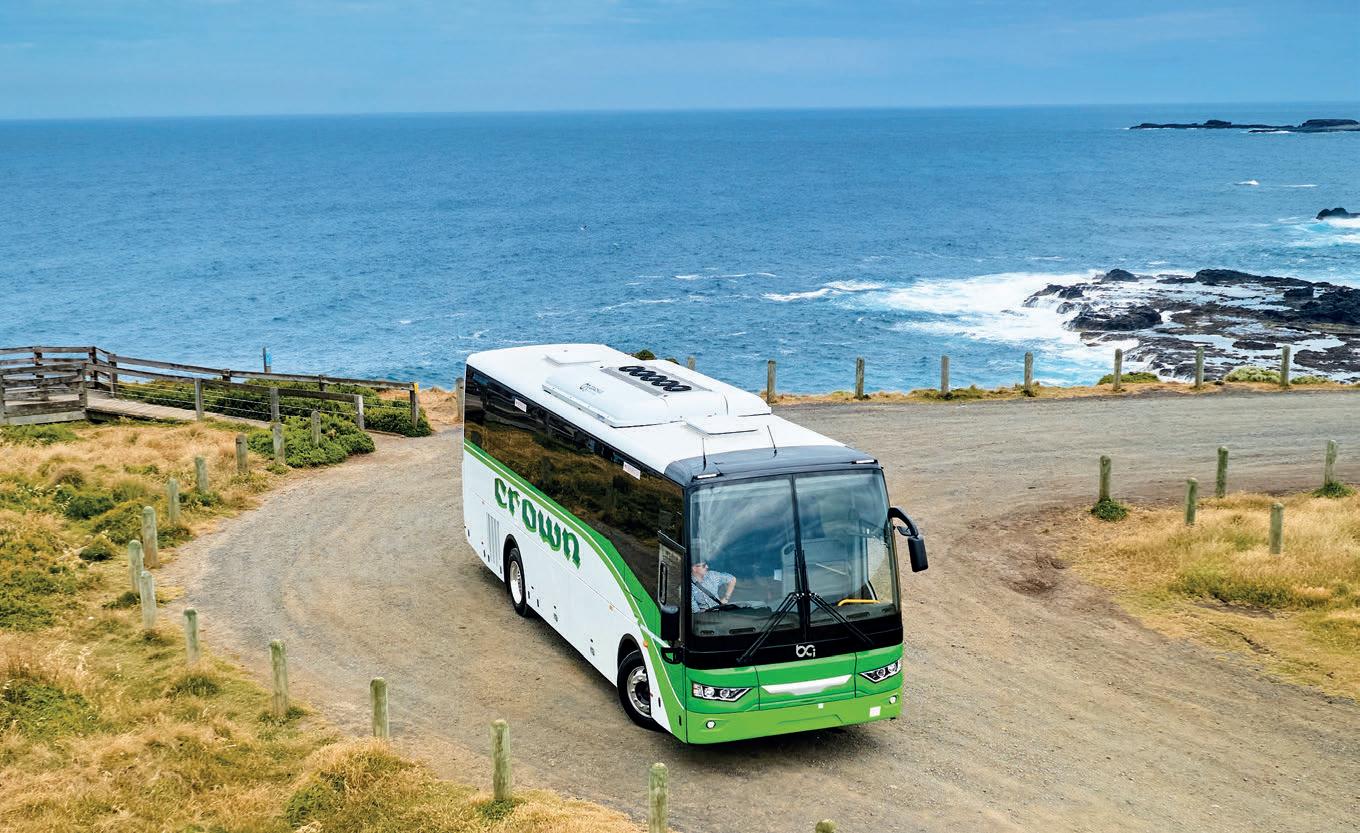
As a medium-sized family business, Crown Coaches is punching above its weight courtesy of a new electric bus partnership that extends its enduring bond with supplier BCI
WORDS SEAN MORTELL IMAGES BCI & PRIME CREATIVE MEDIA
Ivan Furlanetto is not one for going half-in. He’s self-admittedly someone “from the blue sky department” and is brimming with energy as he shows me around the twin depots that are the home of Victorian operator Crown Coaches.
Much like the Nunawading-based company that he is the business development manager (BDM) of, Furlanetto operates with the mantra that tomorrow is going to be a better day.
This philosophy has been boosted by a recent delivery of BCI battery electric buses that is allowing Crown Coaches to realise its environmentally friendly potential.
“Crown Coaches has always had sustainability in its DNA,” Furlanetto told ABC
“We pride ourselves on being one of the early adopters of sustainable bus technology in Australia.”
The family-based business has become a long-standing member of the south-eastern Melbourne community a er first being founded by Victor and Julie Haoust in 1967.
Having operated for nearly 60 years, the next generation of directors in Renee and Jerome Haoust have taken over the baton from their parents and work alongside Ivan Furlanetto and general manager Daryl Kirkwood in the leadership team.
While the Australian bus and coach industry has progressively turned its focus towards zero-emissions networks in recent years, Crown Coaches was ahead of the game when it introduced one of Victoria’s first 100 per cent electric buses in 2009. Courtesy of BCI, Crown’s electric foray of three vehicles was soon joined by an order for five hybrid models around the same time.
“Crown Coaches was a very early adopter back then and therefore experienced a lot more teething problems with the technology,” Furlanetto says.
“While it may not have been an immediate success for us, we learnt a lot about the unknowns of using the technology and shared this knowledge with the industry.”
The initial BCI first generation
Above: BCI has extended its partnership with Crown Coaches into the electric sphere
electric buses may not have been an immediate hit, but they lay the foundation for Crown Coaches’ current zero-emissions focus. The operator kept its hybrid models in service until the COVID-19 pandemic hit Australia, with Crown Coaches using the opportunity to retire its hybrid fleet and instead investigate new avenues to sustainable transport.
It started with Crown’s diesel vehicles when a partnership with Viva Energy allowed the operator to use opt-in carbon neutral diesel. Within three months of learning about the fuel technology, the medium-sized Victorian family bus business changed fuel suppliers.
“Since January 1, 2023, we have used opt-in carbon neutral diesel from Viva Energy to reduce our carbon footprint – to date we have abated 4.9 million kilos of CO2,” Furlanetto says. Following the successful opt-in carbon neutral diesel move, Crown Coaches was faced with a crucial decision to make when long-time chassis OEM Mercedes-Benz announced it was ceasing
manufacturing buses and coaches in Australia. The Crown leadership team banded together and realised they were at a fork in the road – they could either order all new diesel vehicles from another popular chassis OEM in Australia or instead find a partner to begin an immediate transition to an electric bus network.
As is the optimistic way of Furlanetto and Crown Coaches, the family business decided to take a leap of faith and commit to only buying electric buses.
“We went the way of forming a goal to only purchase electric bus and coaches moving forward,” Furlanetto says.
“Whether that comes to fruition or not is reliant on supply chains and infrastructure, but we have done everything we can to date to fulfil this aim.”
When it came to finding an electric bus partner, Crown Coaches didn’t have to look far. For more than 25 years, Crown Coaches has dealt with BCI for its body needs. Furlanetto has been an integral part of the relationship for many years, having been BCI’s CEO for 10 years up until 2016 before joining Crown Coaches.
The partnership has included supplying Crown Coaches with its first electric buses back in 2009. Fast forward to today, where BCI represents approximately 70 per cent of the bodies in Crown’s 163 coach fleet in the large and medium fleet segment. All of this history between the two companies made it a natural fit to work together on Crown’s audacious electric vehicle mission.
“The relationship between Crown Coaches and BCI commenced in the

late ‘90s and has always been there in various shapes or forms throughout the years since,” Furlanetto says.
“For years we were buying BCI bodies on Mercedes-Benz chassis, so Mercedes-Benz’s withdrawal from the market became the catalyst to order five BCI electric bus models.
“They’re the ideal body and bus for us. We appreciate how BCI works with its partners and is able to engineer buses and coaches that are well suited to our needs.”
From BCI’s perspective, it was an exciting day for national sales manager Cameron Millen when Crown Coaches came to them and informed them of their electric vehicle vision.
“They came to us in 2022 saying they wouldn’t buy another diesel bus, so it’s been a wonderful project to work on with them,” Millen told ABC
“It’s great to see an operator not just buying one bus for a trial, but instead properly introducing the technology and supporting it with
Above: Crown Coaches has introduced temporary chargers to overcome supply chain issues
Below:
The deliveries are second generation BCI battery electric models
the correct infrastructure without any government funding.
“They’ve been one of our longer-standing customers and it’s terrific to be able to continue this partnership in the electric space.”
While Crown Coaches’ electric vision may have sounded like lo y goals to attain at the time, the operator quickly backed up its call with an investment in electric bus infrastructure. At its Nunawading home base, its first tranche of Hitachi charging infrastructure allows for 14 buses to be charged simultaneously. In the second stage, charging capacity will increase to 40 buses simultaneously, with underground conduits, an upgraded transformer and a new distribution board all being key to the infrastructure investment.
“The second generation electric buses that Crown Coaches are now receiving are extremely different to the first generation ones they ordered back in 2009,” Millen says.

“No one else was supplying them in Australia back then and Crown Coaches was the first operator to receive them. The technology was very different – these first generation models had industrial motors and manually balanced battery packs.
“Now, Crown is receiving variations of our second generation model that we first introduced into Australia back in 2019.”
The first five electric vehicles delivered are Disability Discrimination Act (DDA) compliant 43-seat models, with 281kWh batteries onboard. The next five that will be delivered by BCI before the new school year will be 57-83 charter and school coaches with 422kWh onboard.
This diverse fleet highlights BCI’s evolution as an electric bus supplier in Australia. Millen says the brand has recently introduced a 12m low-floor electric model in Sydney and plans

to roll out a 10m version in the coming months.
“We’ve worked with Crown Coaches to ensure that these buses work in their depots and have helped locate charging ports to fit in with their infrastructure,” Millen says.
“Our 12m buses have charging ports on both the front and back –Crown Coaches spent at least six months finalising the design and build of the buses to suit its needs.”
Furlanetto says the quality of BCI’s models has ensured Crown Coaches remains confident that it made the right choice throwing all of its chips down the electric path. With some of the delivered buses now out running specialist runs and private school routes, initial feedback is proving that Crown Coaches is onto a winner and drivers are asking if they can be considered to drive the next lot of vehicle deliveries.
“I’m all about warranties as this is an indicator of how much suppliers believe in their products’ longevity,” Furlanetto says.
“One BCI bus has been on the road for three weeks and it’s receiving great feedback from both our drivers and passengers.
“With a company of our size not being mandated to report our emissions, we strive to use best practice and be leaders in this space. We are investing our resources and profits in what we believe in.”
Crown Coaches is only at the start of its transition, with the operator training its workshop staff to maintain and drivers to drive the electric vehicles and establishing the infrastructure required to support the
influx of new-age models. Furlanetto says the company’s plan is to continue consistently ordering electric buses to steadily replace its diesel fleet while having the capacity to charge 40 electric buses by 2026.
While doing so, Crown Coaches also announced in April that it is exploring the possibility of selling the business. Furlanetto says the operator is only at the very start of this process, but its three-to-five year plan is to develop an electric bus network that is an enticing prospect for the right business partner.
“This is an enduring family business and we want to grow the company’s operations with the help of a potential suitor,” he says.
“We now have the makings of a true depot in a box where our learning can be replicated at other depots – we’ve done the hard yards so that others can help us enjoy the fruits.”
The nature of BCI and Crown
Below:
The operator has installed Hitachi charging infrastructure, with compliance testing and safety barriers to be done prior to switch on
Coaches’ partnership may be changing before the industry’s very eyes, with the pair remaining committed to working together in the future. With the help of BCI, Furlanetto is using his trademark positivity to encourage the industry to learn from Crown Coaches and build an electric powerhouse that can make the world a cleaner and more sustainable place for the next generation.
“I encourage other operators to take up the challenge of having zero-emissions buses in their fleets as this technology is not a trial, you simply need to start and learn through the process as we’ll all have a part to play,” he says.
“It’s all about being at the forefront of technology as early adopters. We’ve done the best we can courtesy of BCI, and tomorrow will be a better day for operators following Crown Coaches on the road to lowering emissions.”
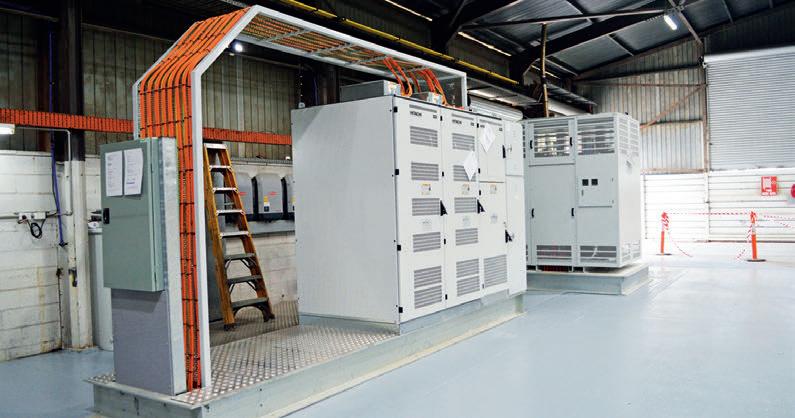






ABC chats to four states about how they’re juggling the infrastructure challenges involved with the zero-emissions change in the Australian bus and coach industry
WORDS SEAN MORTELL IMAGES QUEENSLAND DEPARTMENT OF TRANSPORT AND MAIN ROADS
Just a few years ago, the initial goals mapped out for the Australian bus and coach industry’s zero-emissions transition seemed like miniscule blots in the distance. Now, these deadlines are looming large on the horizon, with many Australian state and territory governments beginning to progress on meeting their decarbonisation targets.
So what’s slowing the progression towards a sustainable bus and coach transport future? ABC reached out to all Australian state and territory governments to determine the inner workings of their individual bus and coach transitions. Four states responded and outlined the key issues that they’re working through to have sufficient zero-emissions bus infrastructure ready to meet upcoming targets.
Currently, the largest zero-emissions bus fleet in Australia operates in New South Wales, with the state government and Transport for NSW (Transport) combining to run 130 buses in service, with 127 of these in Greater Sydney and the other three in Newcastle. Under its Zero Emission Buses (ZEB) program, roughly 8,300 buses will be transitioned to sustainable technology to meet the state government’s net zero-emissions target by 2050.
“The first stage of the NSW ZEB program involves introducing 1,219 new electric buses to services for Greater Sydney customers by 2028,” Transport ZEB program director Andrew Milne told ABC.
“As part of the first stage, 11 existing bus depots will be converted to battery electric technology to support
Above: State governments have different approaches to developing zero-emissions infrastructure
Below: Queensland has ordered 200 ZEBs
the new electric fleet, while a new electric bus depot will be built in Macquarie Park.”
With the expressions of interest for the design and construction of the state’s Macquarie Park Depot now closed, the successful tenderer will be appointed later this year and

construction will begin next year with the end goal of completion in late 2027. Coinciding with this infrastructure focus is Transport’s first multiple electric bus order that is part of the Greater Sydney Stage 1 transition and the ongoing bus replacement program.
Transport has audacious goals – it intends to complete the transition in Greater Sydney by 2035, in outer metropolitan regions by 2040 and then in regional NSW by 2047. For such long-term objectives, it has a long-term focus, with Transport looking to order new buses, deliver infrastructure and transition at a steady rate to prevent a production cliff where orders drop at the end of the transition and leave manufacturers in a lurch.
“Delivering a staged transition means new technology innovations can be assessed along the way, so decisions made at each state of the rollout capture the latest technology innovation, performance and lessons learned,” Milne says.
In Greater Sydney, where the transition is currently underway, nine operators are managing more than 4,000 buses. Once this wide-scale change has been made, Transport has to adjust to the completely different regional landscape, where more than 400 operators run regional bus routes, many with fleets of five buses or less.
So far, Transport’s major obstacles in the zero-emissions transition have been with the power upgrades required. To combat this, the state has begun power upgrades to convert the necessary depots, with the state government funding all electric bus fleets and required infrastructure, including chargers, as part of the first stage of changes.
Alongside the ordering of new electric buses to meet an increased zero-emissions demand in the city, 11 Sydney depots are being converted to feature battery electric infrastructure technology. Transport says these depots will be tailored to suit operational requirements, with charging options varying from plug-in to pantograph charging.
“TfNSW has been working closely with the industry to understand existing constraints and mitigations in getting the stock to meet our targets,” Milne says.
“In line with NSW government commitments, we’ll progressively increase local content in zero-emissions buses to a 50 per cent target, which will become the
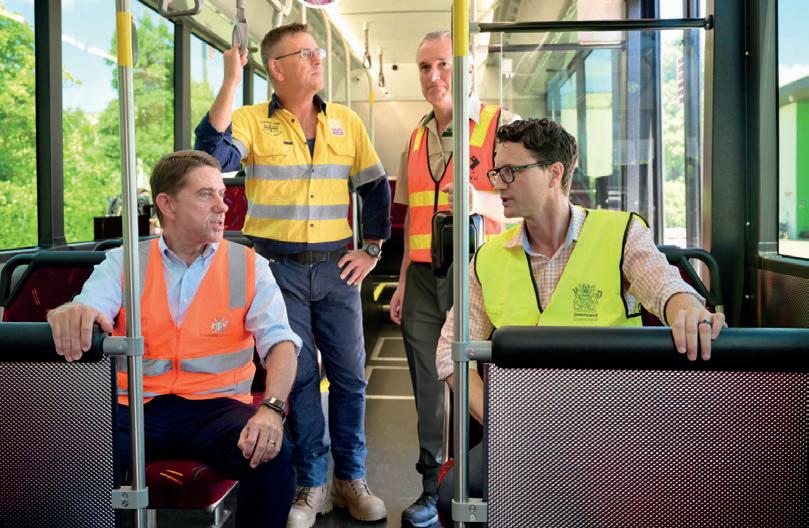
minimum requirement from 2027.”
Another key consideration for Transport has been to ensure electric buses delivered are added into the system effectively and smoothly.
According to the NSW Bus Industry Taskforce’s second report released earlier this year, approximately $35 million of state-financed bus assets in the form of more than 50 battery electric buses were placed in storage for up to a year due to a lack of required charging infrastructure.
Now advancing on its zero-emissions journey, Transport is ensuring the management of its vehicles and infrastructure will go hand-in-hand to prevent any such issues in the future.
“The management of zero-emissions infrastructure and fleet deployment is a key focus for Transport, and we have learnt a lot from recent orders for locally manufactured battery electric buses being delivered as part of our bus replacement program,” Milne says.
“These buses are being progressively brought into service as battery electric charging infrastructure is installed.
“We are partnering with our operators to ensure the battery electric charging infrastructure being installed at individual depots is tailored to suit the operational requirements, capacity and other constraints within each depot.
“We want to ensure that depots can continue to operate their regular services while the conversion is occurring. This is achieved through working closely with operations to understand their operational needs.”
Victoria Down in Victoria, the state government and bodies don’t have quite the same plan as seen in NSW,
with Victoria regulating that all new public transport buses purchased from 2025 onwards must be zeroemissions.
The state’s goals of achieving net zero-emissions throughout the entire state by 2045 are, according to a Victorian government spokesperson, “world-leading”. This feat requires transitioning roughly 4,500 diesel buses to zero-emissions, with its $20 million, three-year zero-emissions bus trial beginning the process.
The three-year trial ahead of the 2025 mandate has seen 52 zero-emissions buses introduced into fleets, with 50 electric and two hydrogen fuel-cell models running across Melbourne, Traralgon and Seymour. While this trial has helped determine how depot charging will happen, the state is yet to begin a large-scale conversion towards zero-emissions infrastructure.
“Through the trial, we’re exploring the challenges and opportunities that different zero-emissions technologies offer in a Victorian context and sharing that information with the local industry to ensure a smoother and more informed transition,” the spokesperson told ABC
Currently, the state government is developing a Zero Emissions Bus Transition Plan to establish a proposed approach to the transition, including how operators will be supported and what the infrastructure will look like around the bus network. The plan is expected to be released this year before the transition properly begins in 2025.
The Victorian government says it’s considering “various approaches” to funding the transition, with extra funding previously being announced in the 2023-24 Victorian budget to support zero-emissions bus orders. The main example of this was at

Ventura Bus Lines’ Ivanhoe depot, which was converted to a completely zero-emissions site featuring 14 dual-gun Tritium fast chargers.
Outside of this, the future of the state’s ambitious decarbonisation goals remain unknown until further reports and approaches are made public.
In South Australia, the state has already ceased ordering diesel buses, with hydrogen and electric technology being trialled.
“The SA government’s first battery electric bus is in service and another nine are on order,” a SA government spokesperson told ABC
“In addition, two hydrogen buses are being trialled across the network and a second electric bus is also being trialled by an Adelaide Metro bus operator. The Department for Infrastructure and Transport is finalising a transition plan and business case to support the transition to zero tailpipe emissions in the Adelaide Metro bus fleet.”
South Australia is combining its decarbonisation goals with its bus replacement program. With the state’s department having to replace more than 35 buses per year as part of the program, the orders for new buses will be exclusively zero-emissions from 2025 onwards to ensure a full fleet replacement by 2050.
Currently, the state government says its electric buses can be managed with the existing charging infrastructure within depots.
However, with challenges surfacing around the power feed, long-lead infrastructure items and the rollout of infrastructure in an operational depot, the state is now trying to better plan for a sustainable bus future.
“Infrastructure upgrades to achieve the transition represents one of the key challenges and the transition plan
and business case directly addresses how the Department will achieve this,” the spokesperson says.
“The infrastructure will then be introduced progressively across the Adelaide Metro bus depots in line with the transition plan.”
The final state to provide an insight into its zero-emissions transition was Queensland, with Transport and Main Roads Minister Bart Mellish telling ABC that the state has set clear targets with the upcoming 2032 Olympic Games on the horizon.
“From 2025, every new bus on the south-east Queensland network will be a zero-emissions vehicle, with the ZEB rollout on our regional network continuing from 2025 to 2030,” Mellish told ABC
“We have developed a model for the transition to zero-emission buses that supports our bus manufacturing workforce and its transition to zero-emissions technologies.
“We are fully committed to a seamless transition for our fleet and workforce to ensure we reach our emission-reduction targets.”
Queensland has already taken a bold step in its overarching plan, with the state government recently announcing it has ordered more than 400 new zero-emissions buses. Through stakeholder partnerships, it’ll own the buses and put them into the network through its operators.
As part of its plan, the zero-emissions bus program will work with Queensland-based manufacturers to build the massive order. New and existing depots will be fitted with the technology required to transition to zero-emissions technology. Mellish says these existing facilities will be critical to a successful rollout, with the department engaging with industry
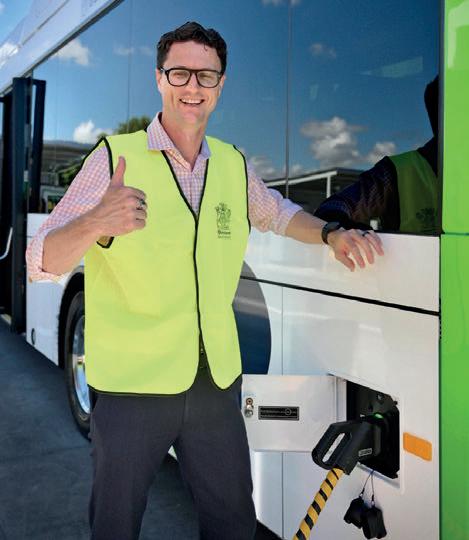
and operators to begin planning for the change before next year.
“The ZEB program aims to reduce bus fleet emissions by up to 80 per cent,” Mellish says.
Above: Queensland Transport and Main
Roads Minister Bart Mellish
“In 2021, a trial of battery electric buses started. Translink now has 75 zero-emissions buses being trialled by operators at eight depots across Queensland.”
The state’s goals are clear – it wants to be running on 50 per cent renewable energy by 2030 and be net zero by 2050.
Much like the rest of Australia, Queensland has sizeable ambitions. The challenge is now whether it can plan the partnering infrastructure to produce a zero-emissions bus network that meets its strict sustainability requirements.
“My department is currently prioritising the delivery of infrastructure to support charging capabilities for zero-emissions buses at existing and new depots throughout south-east Queensland,” Mellish says.






































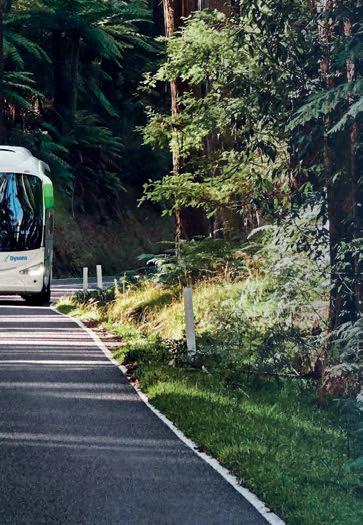

















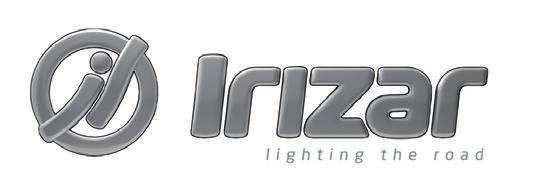


Amid a decision to streamline its fleet, BLK Auto has reinstated a former midi member of its President range
SEAN MORTELL IMAGES BLK AUTO
In recent years, BLK Auto has had a range that caters for any application an operator could think of. Whether it be route services, coach or charter runs or the growing school bus market, BLK Auto’s extensive suite of models has ranged from diesel to the latest in zero-emissions.
It’s now set to be tweaked, with BLK Auto streamlining its wide range of vehicles on offer while also re-introducing a popular option for operators.
“We’ve looked at our product range recently and condensed it to make it more appealing to customers,” BLK Auto national sales manager Mark Nichols told ABC
The streamlining process began in the past year when the federal government introduced new Australian Design Rules (ADR) for the bus and heavy vehicle industry,
including the enforcement of lane departure warning systems, advanced emergency braking and Euro 6 engine emission vehicles.
When it comes to Euro 6 vehicles, ADR 80/04 regulates that all new heavy vehicle models being delivered to Australia from November 1, 2024 must be Euro 6 engine emissions at the least, with all existing heavy vehicle models being supplied to Australia from November 1, 2025 onwards having to comply to the standard. ADR 99/01 mandates that lane departure warning systems (LDWS) have to be included on heavy vehicles.
Finally, the announcement of an ADR requiring AEB systems to be on all new buses from November 1 this year signalled a new era of safety requirements for Australian buses and coaches.
These changes made BLK Auto
Above: BLK Auto has streamlined its fleet and reintroduced the President 10
Below: The change will ensure BLK Auto’s models have consistent styling
review its current fleet of vehicles, with the Australian distributor deciding to streamline its options to make it easier for operators.
“There was a mix of reasons behind us deciding to look at our products and condense them,” Nichols says.
“While the ADRs played a major

part, another reason was that we wanted to modernise the look of our buses and continue to offer a smaller seat option into the range.”
The change to its fleet means BLK Auto has refined its popular President range of vehicles, with the President 2 and 3 models being joined by the re-introduced President 10. The 10m variation of the bus will feature the same styling as its longer siblings, providing a stylish and updated range.
“We’re going to have a very modern and sleek fleet – we review our fleet every five years to ensure the styling remains attractive for operators,”
BLK Auto operations manager Kylie Bellamy told ABC
“This makes it both more appealing to customers but also easier to build in our factory. The President 10 will complement our President 2 and 3 models, as well as our Citystar range.
“The goal is that if someone purchases one of each model, they’ll have the same style bus in terms of componentry, parts and look.”
Bellamy says BLK Auto undertook extensive market research before making the change, consulting with customers to hear what they want to see from BLK Auto. The end result was a more modern look and consistent componentry and parts to make running a fleet easy.
BLK Auto responded to this, maintaining the boutique build it’s known for and condensing its fleet size from an array of models.
“We know that everyone is suffering from production timelines, so this allows us to reduce it,” Bellamy says.
“Instead of having an eight to nine month build time, we may be able to reduce this over time to around the four to six month mark.”
Right: The President 10 is a smaller 10m version of the popular model
Below:
The President 10 features the same styling as its fellow President 2 and 3 models
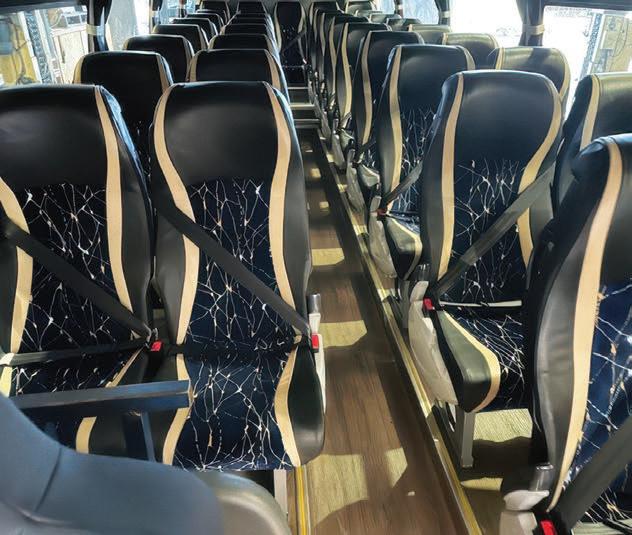
feedback also allowed BLK Auto to determine that operators who buy the 57-seat President 2 are now looking at a smaller option, hence the reintroduction of the President 10. Bellamy says the choice was confirmed when the factory agreed with what customers were saying regarding componentry, look and size.
“The market has dictated the change – when you see the quantity of Senator range models we were selling before and a er COVID, it made it easy for us to streamline the fleet,” Bellamy says.
“It was a model that was due for a revamp – instead of working on that, we wanted to focus on bringing the President 10 model to our homebase in Yatala, Queensland.
“So far, the feedback has been fantastic and has confirmed that we

made the right decision.”
The President 10 used to be part of BLK Auto’s fleet before COVID, with the midi sized bus not being as in demand as it is now. With tour and charter operators now calling for buses of that size, Nichols knew now was the right time to bring the President 10 back.
“The design of the new President 10 means people can identify the entire President range by the look of the front, regardless of if it’s a 10m, 12.3m, 13.2m or 14.5m variation,” Nichols says.
“We want customers to be able to identify us from the front of the bus. While we had the foundations of the President 10 with us for some time, we’ve brought in a new design that complements our current fleet.”
The versatile model can be used for a variety of applications, including for school, inbound and tour operations. With both inbound and charter work continuing to return to pre-COVID levels, BLK Auto is preparing for the boom with the President 10.
The returning model, like the rest of its streamlined fleet, will continue to be serviced by BLK Auto’s comprehensive a ersales package, which includes 24/7 service and more than $1.8 million stocked in spare parts.
“We stock a variety of BLK Auto and other OEM parts because we’re trying to provide a total package for our customers,” Nichols says.
“It’s not just about buying the bus – we want to be a partner for the vehicle’s entire lifespan, meaning that spare parts and a ersales become very important.”




them for this year's
From drivers to operators, veterans to newbies, all well-deserving bussies are eligible to receive one of eight awards to be presented at the BIC National Conference in Hobart this November.
The Awards recognise excellence in Australian bus and coach, with categories for National Achiever, National Safety, National Environment and Innovation, National Outstanding Contribution, National Supplier of the Year, National Operator of the Year, National Driver of the Year, and National Apprentice/Trainee.





Although VDI only started bringing electric Yutong buses to Australian roads in 2018, the global brand’s experience with zeroemissions bus technology is richer than many expect.
While the electric bus transition in Australia was first met with hesitancy over safety and reliability, VDI, the Australian distributor of Yutong buses, has spent the past five years introducing Yutong electric models that have had a major impact on the nation’s electric bus market.
VDI’s forward-thinking approach to bus electrification has allowed it to now sit as the national distributor of one of the best-performing electric buses in the country.
A er bringing over a single electric E12 prototype five years ago, VDI general manager Lou Riccardi says the transition to electric fleets is something VDI pushed for early on.
“Given VDI’s long heritage within the industry, we realised early on that the transition to electrification
represents one of the most significant changes this sector has experienced in the last century,” Riccardi told ABC
“Battery electric bus (BEB) fleets have profound implications across virtually all aspects of an operation, ranging from capital expenditure, depot design, vehicle (especially battery) selection and performance, technology, servicing and, very importantly, safety.
“It was clear that Yutong’s offerings would be a great starting point for this zero-emissions transition.”
The E12 quickly garnered national attention, with the vehicle battery design and performance proving to be a stand-out in the industry. When first introduced, it featured air-cooled batteries and a sleek body design –VDI knew it was onto a winner with the popular electric bus model.
“In 2023, a major order was made by Transport Canberra for another 90 units of the E12 and everything evolved very quickly from that moment on,” Riccardi says.
“It wasn’t long before we became
Above:
VDI and Yutong’s Australian partnership is resulting in a wide range of electric bus models
Australia.”
The relationship between Yutong and VDI has since fostered a slew of technological advancements that has seen Yutong begin adapting its buses to suit Australian roads.
“The partnering VDI has undertaken with multiple operators and governments across Australia has enabled us to determine what’s most important to them,” Riccardi says.
“Working closely with Yutong, these learnings have been incorporated within the various models we retail here in Australia.”
One of the stand-out changes has been the evolution of battery technologies and safety measures.
“The batteries have moved from air-cooled systems to liquid-cooled,” Riccardi says.
“We’ve also introduced the YESS system in our battery technologies that has now been incorporated into all of our vehicles.”
When it comes to zero-emissions

bus safety, Riccardi says protecting electric batteries is the main priority. The four-pronged approach with the YESS system starts by reinforcing the areas of the bus that surround where the batteries sit.
The brand has since then ventured into incorporating thermal management, nitrogen injections and an additional fire blanket with its electric bus deliveries to sweeten the deal for operators.
VDI and Yutong went with quality components to overcome this concern. The class leading CATL batteries within Yutong buses apply a State of Health (SOH) metric for degradation performance purposes.
“Pleasingly, the degradation experienced across our E12 BEBs currently operating in Australia is performing greater than the theoretical modelling supplied by Yutong,” Riccardi says.
Based on what operators have experienced to date, battery degradation is not envisaged to fall below 80 per cent SOH within their eight-year warranty period.
For the 422kWh rated batteries, their SOH is not anticipated to degrade below 337kWh during the first eight years, providing a durable product for local customers.
VDI attributes the battery performance qualities within the E12 to the class leading CATL batteries they are equipped with.
These popular batteries include the key ingredient of Lithium Iron Phosphate (LiFePO4) technology which makes them the most stable battery option in the market due to their superior stability in high vibration and impact environments.
“Their overall performance and their reliability over the years has been outstanding,” Riccardi says.
All of these factors make for an electric bus that covers all facets, allowing Yutong and VDI to show no signs of slowing down in the electric bus transformation.
“We want to continue working closely with Yutong so that Australian operators get access to buses that have actually been developed for Australian conditions,” Riccardi says.
“We are focused on assisting the Australian industry to transition to a battery electric bus fleet through the provision of our expertise and our commitment to safety.
“This can be seen through our commitment to partnering with operators and listening to what changes they want to see and then implementing them.”
One of the next steps in this process will see Yutong’s E12 low-floor route bus model optioned to allow for pantograph charging at depots around Australia.
Inverted pantograph chargers, mounted on gantries or masts, are poised to revolutionise metro route-bus electric vehicle charging. Riccardi says these innovative systems deliver rapid power boosts while minimising maintenance needs.
“Yutong has constantly been improving its electric product,” Riccardi says.
“They have never stagnated.”
Yutong’s unwavering commitment to innovation and collaboration, evident since its first electric bus in 1999, has seen it continuously improve its products, solidifying its position as a leader in the Australasian electric bus industry.
Looking forward, Riccardi is teasing a new generation of batteries expected to come in 18 months’ time.
“This new development will improve the batteries’ reliability and safety throughout all of our electric Yutong buses in the market,” he says.
“On top of that, it will also be more efficient. Customers should expect to get higher capacity models in a smaller size and make the most out of zero-emissions buses.”
VDI’s partnership with Yutong, and its commitment to innovation and collaboration, has seen VDI grow as a national distributor, dealership and service centre business.
By constantly refining its offerings based on operator needs and market demands, the partnership is poised to deliver a significant boost to clean and efficient public transport in Australia for years to come.
Above: Yutong’s electric bus range in Australia is continuing to grow
Below:
New battery technology is taking Yutong’s capabilities to the next level

For years, Bus Stop Sales has had its eye on introducing electric bus technology to Australia. Its partnership with King Long allows it to be at the forefront of sustainable change

The Australian bus and coach industry is on the brink of monumental change with the ongoing transition to zeroemissions solutions.
Bus Stop Sales is one supplier that strongly desires to be at the forefront of this transformation. The bus and coach distributor’s commitment to sustainability both in bus products and at its Rocklea head office has now won multiple awards for its self-funded sustainability projects.
“With a deep understanding of the industry and focus on innovation, we established Bus Stop Sales to customise solutions for our valued bus and coach customer base,” director Pete White told ABC
“Initially, the company focused on importing and distributing a single-make bus. However, as destiny has a way of working, we quickly outgrew this model and are now known to be the only end-to-end supplier catering to the diverse industry needs for 12 to 70 seats, diesel or electric and high-floor coach or urban city bus solutions.
“Our collaboration with the world’s largest bus manufacturing group, King Long is a best case partnership model that has set the stage for the
transformative journey.”
All parties understand that a partnership needs to be win, win, win across the manufacturer, distributor and customers.
The partnership between Bus Stop Sales and King Long also allowed the former to work with the first movers in battery electric buses, with King Long being well ahead of its time in the space. The early adopters of the technology were centred in China in the late 1990s and early 2000s, with King Long building the earliest hybrid bus in China in 1997 and full electric battery electric bus capabilities in 2002.
The combination of the two brands in Australia has allowed Bus Stop Sales to gain momentum and help lead the Australian industry’s solutions for the zero-emissions transport transition.
“We’ve made significant investments into ready-to-go electric bus stock despite the transition being slower than we had hoped. Policy and commitment clarity is crucial to support the uptake,” White says.
Bus Stop has a raw passion for accelerating the uptake of new-energy buses, whether it be fully imported, domestically assembled
Above: King Long’s Apolong Level 4 autonomous bus courtesy of the brand and technology giant Baid.
Images: Bus Stop
or built by Australian content manufacturers.
“King Long is proud to have been in Australia for 16 years and is committed to being here for the long haul. We strive to support the market with the best solutions to meet operators’ needs,” Xiamen King Long director for Australian market share Harvey Zheng says.
“Our strategy has been built on customer choice and the provision of a great product and customer centric a ersales support alongside our distributor. Our goal is to be the best end-to-end solutions provider for the industry.”
While price parity with diesel is still yet to come for electric models, Bus Stop has ticked off the quality side of the equation, with King Long consistently noted as a leading global bus brand for producing battery electric buses.
“With King Long, we work together, focusing on customer requirements and how we can create long-term value for our partners,” White says.
At the distributor level, White isn’t purely focused on buses – he desires to lead a sustainable revolution in public transport while tackling climate change. The director lives these
values daily and has demonstrated through implementing hundreds of initiatives within his organisation across both management and company loan cars, large investments into on-site battery and solar projects, rainwater collection and waste reduction projects at Bus Stop’s Brisbane Bus Centre in Rocklea.
“Uptake has been accelerated as I don’t answer to a board with prolonged business case requirements,” White says.
“It was just the right thing to do commercially and socially, so we moved quickly, and I had no hesitation using personal funds to live the values we hold close to our hearts.”
These moves proved critical when Bus Stop was acknowledged as the winner of the 2023 Queensland Bus Industry Council (QBIC) Innovation and Environmental awards for sustainability.
White is now intent on allowing electric buses to soon become the spine of Australia’s urban, short haul and on-demand transport industry.
“As cities worldwide commit to reducing their carbon footprints and improving air quality, the pressure has mounted on the transportation sector to innovate,” he says.
“Hydrogen is not on our immediate radar – the proposition across economic, technological and environmental arenas have yet to compel significant investment.”
White says electric buses represent a significant technological leap, producing zero tailpipe emissions, requiring significantly less resources per km and having a total cost of ownership (TCO) model that provides a compelling business case on paper.
He says ZEBs are proven to work every day and are ready for deployment on mass right now.
White says he began advocating for electric buses before they dominated

industry discussions. His foresight proved critical in positioning both Bus Stop Sales and King Long at the forefront of the electric revolution in Australia and his group invested early to design and deliver the first sustainable electric school bus in the private education sector.
This hasn’t been without its challenges – White says the infrastructure that needs to be upgraded to support widespread operator adoption, particularly away from their home, hasn’t been adequately developed, meaning careful planning is needed to match the e-bus solution for real-life mission requirements .
While the initial cost of electric buses remains high for operators, White has been proactive in building partnerships with infrastructure suppliers, government agencies, local councils and private companies within the e-bus ecosystem.
“One of the key strategies we undertook was to collaborate with others early across suppliers, technology, energy providers and operators to refine the

range of products and solutions available,” White says.
“We identified early that bus supply is only a small piece of the transition journey, and it’s probably the easiest part of the fleet transition journey. While we can supply within months a high volume of buses to our partners with complete imported bus solutions, for successful deployment of our products, we need the infrastructure to be there.”
Coming from “Australia’s longest-serving bus sales family”, White is confident that his organisation can play a role in pushing past these infrastructure challenges and forging an electric future. He knows that the market is rapidly changing and White is calling on all involved to continue looking beyond traditional ‘lanes’ to collaborate and work across the ecosystems to make the transition easier for operators.
“We’re already exploring partnerships and pilot projects to bring autonomous electric buses to Australian cities, positioning Bus Stop and King Long at the cutting edge of transport technology,” White says.
“We have world-class product options with King Long, all available now – however, we are focused on the fundamentals of our existing range before range expansion.
“I’m passionate about promoting sustainability throughout the entire life cycle of buses, including exploring the use of renewable energy sources for charging, implementing battery second life and recycling programs plus advocating for sustainable manufacturing practices.
“By taking a holistic approach to sustainability, we want to ensure that the electric bus transition is truly transformative and benefits the environment in multiple ways.”



























Dyson Group’s latest regional hub will see it establish a zero-emissions home in one of the fastest growing towns in Victoria
For years, the Dyson Group of Companies, or Dysons, has stood as a pillar of the Victorian bus and coach industry. Based in Melbourne’s north-eastern suburbs and continually expanding since the Dyson family first founded the company back in 1952, the operator has seen a whirlwind of growth in recent years.
With around 700 buses and more than 1,350 employees spread across Victoria and southern NSW, Dysons is now the largest Victorian-owned bus company following Ventura’s recent sale to Keppel Infrastructure Trust. Acquisition has been a common theme among many of the large Australian bus companies over the past decade, but Dysons has bucked that trend and has instead begun preparing for the future.
Dysons CEO and managing director Andrew Jakab is focused on providing better outcomes, both environmentally and operationally, for all Dysons passengers spread across the state.
“Dysons is fully committed to Victoria’s zero-emissions target of net zero emissions by 2045. This means we are proactively investing in a decarbonised future with electrified bus depots in metropolitan and regional Victoria,” Jakab told ABC
“Dysons has re-invested in Victoria for more than 72 years. Nothing has changed. We are incredibly excited about the introduction of electric buses and what that means for passengers and communities where we operate.”
With an experienced executive leadership team maintaining the
Dyson family’s steadfast commitment to re-investment growth and innovation, the business is now poised to put Jakab’s words into action with a groundbreaking project to fast-track zero emissions buses into regional Victoria.
The idea to establish a new regional Victorian hub began roughly five years ago. With depots in Wodonga, Wangaratta, Shepparton, Moama and Deniliquin, and hundreds of Dysons buses criss-crossing north-eastern Victoria every day, it made perfect sense for Dysons to invest in further infrastructure to prepare for the inevitable growth and incoming electric buses across the region.
Above: Dysons is enhancing its presence in Shepparton with its new hub
Below: The mini headquarters will make regional operations easier for Dysons
The search quickly started to find a piece of land in regional Victoria that could hold a Dyson Group regional home base.
It landed on Shepparton – a growing regional hub that sits perfectly in the centre of Dysons’ current regional operations in northern Victoria and southern New South Wales. It also made sense because the current Dysons depot in Shepparton is bursting at the seams.
“It makes sense to situate the depot in Shepparton as it’s central to our operations in the region,” Dyson Group regional operations manager Roy Dyson told ABC
“A lot of our V/Line network

services run through Shepparton, so it creates opportunities for us if we have a secondary mini headquarters established in the region.”
While Dysons’ expansion has seen it grow out of Victoria and into NSW, the operator remains dedicated to continuing its investment within its home state. The Shepparton depot will be its sixth site that it has developed in Victoria, with Dysons once again partnering with industry leader Dzine for the design and construction of the Shepparton hub.
Over the past 18 months, Dysons and Dzine have worked together through the various permit and design plans required.
“Having Dzine on board once again has helped us lots, as they know what we look for and have a lot of experience in building bus depots,” Dyson says.
The new site will include a cutting-edge workshop that features advanced facilities such as brake testing, a fully operational spray booth and a body repair shop. This will alleviate pressure on the Melbourne headquarters, with Dysons’ growing fleet of more than 300 regional buses to undergo major maintenance and body repairs at Shepparton instead of heading back down the Hume Highway to Melbourne.
“It’s been a challenge in recent years completing minor maintenance works in the region – o en we’ve had to engage external sub-contractors to complete the work,” Dyson says.
“Being established in Shepparton means we can hire local and grow our maintenance work in the area. We’ll also have the chance to complete major reconditioning work on our regional vehicles.”
The Shepparton site will also include an administration centre for Dysons’ regional driver trainers and people and culture coordinators, allowing
them all a home base to work from.
With the Victorian government’s policy of all new buses to be electric by June 2025 fast approaching, Dysons is ready and waiting to deliver on those goals in Shepparton.
“Configuring the new Shepparton depot for electric bus operations was considered to be a ‘no regrets move’ which is intuitively aligned to the Victorian government’s emissions reduction policy,” Jakab says.
“While the metropolitan transition is well underway, we wanted to get ahead of the game in the regions.”
Instead of waiting for the hub to be constructed before adding in zero-emissions infrastructure, Dysons got ahead of the curve. With the Shepparton depot providing a fresh opportunity, the operator has laid the groundwork already for electric bus chargers and spaces to house its growing fleet of battery electric buses and coaches.
“We know that installing chargers and infrastructure can be difficult to do later on in a depot’s construction, so we wanted to have the background work done and ready to go from the start,” Dyson says.
“When the time comes and we operate a large zero-emissions bus network, the Shepparton depot will be ready to house the vehicles.”

Although it’s been a lengthy process that has le Dyson and his depot development team frustrated at times, they’re keenly awaiting the opening of the depot. Dyson says the company expects the Shepparton depot to be completed in the opening weeks of September.
Dysons isn’t the only party sitting patiently for the depot to open –Nationals member for Shepparton Kim O’Keeffe is excited about what the hub will do for jobs and opportunities in the regional area.
“The new facility will serve as a

hub for the maintenance and repair of more than 300 regional buses, removing the need to transport damaged buses to be repaired in Melbourne and saving time and resources,” O’Keeffe told ABC

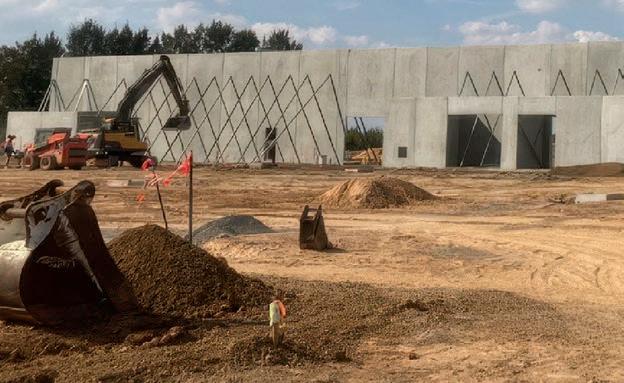
“When companies like Dysons expand their business in such a significant way, it showcases the progress and opportunities in regional Victoria. Its investment in this new facility shows the company’s confidence, not only in the future success of the company, but also in the region.”
O’Keeffe says calls are coming in each day asking for a better bus network in the area, leading to her




raising it with Victorian public and active transport minister Gabrielle Williams. With Shepparton having grown considerably since Dysons acquired Shepparton Transit in 2017, she says there are many who want the bus network in the town to reflect the population increase.
“The population growth has outpaced the network, so this depot gives us the chance to grow in the region,” Dyson says.
O’Keeffe says Dysons’ expansion in Shepparton is testament to the growth of the region, with the last Shepparton bus review conducted 15 years ago. Now, with Dysons nearly set to roll out a site ready for the future, O’Keeffe is one of many looking forward to modern business’ enhanced presence in Shepparton and its surrounds.
“This business is investing in the region, and we need the state government to do the same and fund a bus review for Shepparton,” O’Keeffe says.
“I look forward to seeing the new depot completed, and I congratulate Dysons Bus Group on this exciting next stage of their business.”






Volvo Bus is leading the way locally for operators in the zero-emissions space
As one of the world’s leading bus and coach OEMs, Volvo Bus knows well and truly how to sell a bus to a customer. For decades, the heavy vehicle giant has been around the top of the table for bus and coach sales in numerous global locations.
While it’s well versed on how to design, manufacture and sell diesel buses and coaches, Volvo Bus is now acutely aware that the increasing industry trend towards zero-emissions models requires a different sales process.
“We’re long-term business partners for our customers and we sell an entire systems package rather than just a bus,” Volvo Asia Pacific director of product, industry and electromobility
Mark Fryer told ABC
“We have a process that we follow when an operator orders a zero-emissions bus to determine what charging infrastructure they’ll need to accompany it.”
As Fryer speaks with ABC, he is attending a Volvo Bus Asia Pacific
conference with the region’s sales leaders. The purpose of the three-day conference is to continually upskill the Volvo team on best practice when selling Volvo’s BZL electric buses.
The current process involves discussing the deeper points of infrastructure with the customer, including the charger and kilowatts of power needed to successfully operate the vehicle. From there, a division in Volvo Bus’ Sweden head office runs these requirements through a system of chargers and infrastructure types to find the most compatible option.
Included in this list is a wide range of major charging brands that are compared to the customer’s needs to find the best infrastructure opportunities available for operators.
“There’s no point us selling a customer a bus if it isn’t accompanied by a compatible piece of infrastructure,” Fryer says.
“Selling a zero-emissions bus involves a total package and it needs to be that way moving forward. Selling the bus is the easy part –
Above: Volvo’s electric focus is all about the latest technology
Below: Volvo Bus product director of city Fredrik Björ
we’re now equally focused on the infrastructure required to fulfil an efficient operating strategy for these vehicles.”
While Australia may not be as advanced in its zero-emissions bus transition as other nations, particularly in Europe, there are still key points that Volvo’s head office in Sweden is working on. Volvo Bus Corporation product director of city Frederick Björn says that electric bus

infrastructure now extends beyond simply finding a charger that can power a bus.
“There’s so much more than simply charging a vehicle – there’s additional functionalities that we’re now looking into,” Björn told ABC
“These aren’t clearly regulated yet, but we want to make sure that infrastructure communicates with the bus to ensure there’s full functionality and customers get the most out of their assets.”
Volvo has recently introduced interoperability testing to its buses and infrastructure options to support customers with the testing and selecting of the right chargers. Fryer says it’s all about balancing the vehicle and charger needs with the latest technology involved, including traffic optimisation capabilities and depot sizes.
“When we used to solely sell diesel buses we’d ask how many seats, but now with electric buses we’re asking customers to select the chargers they like, the range they want and the way it’ll be maintained,” Fryer says.
“Our team in Sweden runs simulations on the vehicle model chosen to determine how much energy will be used based on the customer’s route typography and weather. This means we can confidently determine which charger would work well for that route alongside the bus.
“Although we don’t sell chargers, we ultimately want to work alongside our customers to ensure they are purchasing a holistic electric bus system that meets their needs – and we have the flexibility to do just that.”
In Australia, the main type of
charging Volvo Bus is offering BZL Electric customers is plug-in. Globally, pantograph rapid charging has become popular, saving ground space in depots while charging a series of buses quickly. While this technology is yet to become widespread in Australia due to smaller zero-emissions bus fleet sizes, Fryer and Björn are both excited at what pantograph charging could bring for local operators.
“I could easily see pantograph charging being the way forward in Australia – in Europe already it’s been popular as it allows buses to be charged in separate depots,” Björn says.
“In Australia, where vehicles are sometimes parked outdoors, you wouldn’t want to have charging pillars and cables lying around, so it would be easier to bring in a pantograph to keep charging effectively and safely.”
Fryer says Volvo has spoken to some operators about the potential for pantograph charging in the future for depots that are very cramped for space. He thinks that the Volvo head office simulations will be critical to showing customers the benefits of the technology.
“We’re still learning and evolving, but we now have experience in different markets, conditions and sized depots,” Fryer says.
“We’re lucky to have this expertise available to help Australian operators get the best solution. We know we have good people in positions to get the right solutions.”
Having already made a start on its total solution package for the industry, both Fryer and Björn want to continue being involved in conversations with

Above: Mark Fryer is conducting product training for Volvo Bus APAC staff
Below: Volvo is focusing on more than just the bus when selling its BZL Electric model
the sector. Instead of being a trusted seller, Volvo is intent on being a constant partner for operators.
“When you start the zero-emissions journey as an operator, we want to be there for the long journey of establishing infrastructure,” Fryer says. “We know that it’s a two-way street.”
“It’s no longer a one-person job – it’s an exciting time where people have to be armed with a lot more tools and information to help others,” Björn says.
“By continuing to build partnerships, we want to be a helpful guide for all customers when it comes to undergoing bus and coach transformation.”


From its #GreenSchools1000 initiative aimed at rolling out 1000 electric school coaches to accreditation on TfNSW’s Bus Panel 4 and now partnering on the regional zero-emissions bus trials, GoZero Group is gaining pace
IMAGES GOZERO
For GoZero Group, 2024 has been another year of rapid growth. In February, the group that includes local OEM Nexport announced it had secured $80 million in asset finance facilities from Commonwealth Bank of Australia (CBA) to support its ambitious growth targets. A month later, Nexport was appointed as a preferred supplier of buses for Transport for NSW’s (TfNSW) Panel 4 procurement list. Now, off the back of recent executive appointments that include former Red Bus Services general manager Leanne Griffiths, Nexport is expanding its electric bus capability to support TfNSW’s Regional and Out Metropolitan (ROM) trials.
As part of the new regional zero-emissions bus trials in NSW, GoZero Group, via Nexport, will provide electric buses for both the Dyson Group and Edwards’ Coaches to trial in the NSW towns of Deniliquin and Armidale. The trial involves two
Nexport 57-seat electric coaches and two Nexport 25-seat models, with the vehicles starting to operate in the greater Riverina and New England regions towards the end of the year.
GoZero managing director
Stephen Cartwright says the NSW government’s expression of interest process was very thorough, with Nexport’s selection allowing it to design its electric buses and coaches to suit the regional conditions.
“The trial mandated certain features like the installation of bull bars and stone guards to protect against wildlife, stones and rocks hitting the windows,” Cartwright told ABC
“We’ve also designed a battery solution to ensure the bus can meet distance requirements and, as part of the scope of works, we’re providing Dysons and Edwards’ Coaches with the necessary charging infrastructure to cater for the range needed for country runs.”
More generally across the fleet,
Above: GoZero is continuing to evolve through new deliveries and ZEB trials
one of the features of the Nexport models is their underfloor battery packs (rather than the norm of batteries being housed on the roof) providing a stronger yet lighter structure. Cartwright says this tweak has also made the models even easier to drive, with greater stability provided courtesy of the low centre of gravity.
These innovations mean Nexport coaches can travel up to 500km on a single charge.
This flexibility is at the heart of Nexport’s capabilities, with Cartwright emphasising that its local content (which includes manufacturing, engineering and design) means it can adjust its models to suit the different requirements of transport operators.
Whether it be increasing the level of torque in a vehicle to get up steeper hills or high-tech safety features like fire resistant flooring and seatbelts as standard, this
versatility has been a key reason for Nexport’s inclusion on TfNSW’s procurement list.
With seatbelt detection systems installed alongside a safety package that includes emergency braking, lane departure warning, driver fatigue monitors and a camera that Cartwright says is better than a bird’s eye view to prevent collisions, Nexport’s range isn’t just sustainable – it’s incredibly safe to drive as well as travel on.
“The design of our buses includes a large window close to the entry door that allows drivers to see if someone is in their blind spot,” Cartwright says.
The system provides warnings both on the inside and outside of the vehicle as standard.
“We always say Nexport CARES – which means our models are Comfortable, Accessible, Reliable, Efficient and Safe,” Cartwright says.
Nexport’s focus on local content, sustainability and the latest safety technology will remain at the forefront of GoZero Group’s ongoing expansion in the Australian market.
“GoZero Group, with Nexport’s latest vehicle technology, has a complete package for operators wanting to introduce electric buses to a variety of environments, from city to regional and outer metropolitan,” Cartwright says.
“We already have more than six million kilometres on the clock with our electric buses driving city routes, so we’ve got a lot of operational experience with electric transport.
“Being a local OEM, we can select components and options that are perfectly suited to Australian conditions. We have a variety of

global and domestic suppliers for our bus components.
“We also continually change our models to further reduce weight, because we know that the future of zero-emissions transport is in the kilos, not the kilowatts.”
Choosing a light body structure has allowed GoZero Group to select Australian steel for its buses and coaches. This means that the bottom of the build starts with Australian components with the plan to steadily increase local content over time.
In line with the ‘Made in Australia’ agenda of Australian governments, GoZero plans to expand the company’s manufacturing footprint on the eastern seaboard.
Outside of the vehicle production side, GoZero Group is also enhancing its deep analysis of operational circumstances to help operators
Above: Cartwright (second from le ) with (from L to R) CBA’s Jane Thomson and Matt Comyn, and GoZero Group chair Spiro Pappas
Below: Nexport’s models use Australian steel

make the transition to zero-emissions.
The GoZero team’s combined extensive operations experience and wide-ranging partner ecosystem enables them to advise on and deliver the right charging infrastructure options for operators across a variety of settings.
While GoZero Group is evolving rapidly in the public sector through Nexport’s Panel 4 inclusion and the TfNSW ROM zero-emissions bus trials, it’s continuing to ramp up in the private sector as well. The company has just completed the supply of 16 electric buses to Swissport to upgrade the fleet that supplies Qantas with transport services.
As part of its sustainable growth strategy, Swissport is investing more than five million Aussie dollars in 2024 in environmentally friendly electric ground handling equipment for its Australian and New Zealand operations. By the end of next year, almost half of Swissport’s fleet in the region will be electric, in line with the company’s global commitment to achieve net zero emissions by 2050.
“Our partnership with Swissport is an example of the flexibility that comes with working with a local OEM like Nexport – these buses are purpose built for the airport environment to carry people and luggage,” Cartwright says.
Through Nexport’s innovative and flexible bus and coach models and GoZero’s breadth of offering, the group has established itself as a trusted partner for operators at every stage of establishing a zero-emissions bus fleet.
“It’s onwards and upwards for GoZero Group,” Cartwright says.

A er recently establishing itself as an independent entity, Bus Finance
Australia is using 20 years of history to provide new funding packages for zero-emissions vehicles and their infrastructure
IMAGES BUS FINANCE AUSTRALIA
For 20 years, Bus Finance Australia has provided a helping hand to many Victorian and national bus operators, big or small. When finance director Brett Collins first decided to establish the business in 2004 from scratch and provide a funding offering for bus operators, the idea was to start and create specific finance packages to suit bus operators’ requirements.
Now, two decades on from Collins’ initial foray, Bus Finance Australia has officially become its own independent entity and has grown from a Victorian service to a national bus industry financial pillar.
Following this, Collins is turning his focus towards the next stage of innovation in the industry.
“We can now confirm that Bus Finance Australia is truly independent
and runs as its own entity,” Collins told ABC
“We used to be part of the Bus Association of Victoria’s (BusVic) suite of businesses, but now we run independently.
“Alongside our new entity in EV Infrastructure Funds, we are up and operating as our own successful business.”
With the new-look Bus Finance Australia, the EV Infrastructure Fund adds another dimension to the business’ capabilities. While Bus Finance Australia will continue to look a er the usual day-to-day bus finance and business purchases for operators of all sizes, the EV Infrastructure Fund side will focus on all associated capital relating to the infrastructure required to support zero-emissions vehicles. Whether it be battery electric
vehicle charging or hydrogen fuel-cell bus infrastructure, the EV Infrastructure Fund will be available to help fully fund operators as they make the sustainable switch.
“Our EV Infrastructure Fund has its own dedicated pool of funds that isn’t bank aligned and is designed to support bus operators for this transition,” Collins says.
“It’s been established specifically to assist bus operators and will offer significant features and benefits that a traditional financier isn’t able to do.”
The latest move from Bus Finance Australia, who was formerly known as BAV Finance when part of the BusVic family of businesses, will see it build on more than $850 million in finance transactions it’s made to support the bus industry. With an end goal in place to become the leading financier
for Australian bus operators, the EV Infrastructure Fund will replicate the brand’s approach of providing financial services for both the single bus operators and the largest of corporate businesses.
This new fund will help bus operators all sizes but will provide significant support to larger bus operators and governments while remaining as a key tool assisting tenders.
Collins says the fund comes about a er Bus Finance Australia identified that zero-emissions buses have become a popular model of choice for operators. He sees the funding of electric and wider zero-emissions models and their infrastructure to be a natural progression for both the industry and Bus Finance Australia.
“We’ve seen where Australian governments want operators to go to regarding the transition and we’re helping to support them on their journey,” Collins says.
“The EV Infrastructure Fund will provide, in most cases, 100 per cent funding for all associated equipment and infrastructure involved in supporting electric and hydrogen buses.”
This includes depot renovations and modifications, alongside standard charging equipment, energy equipment, batteries, fuel cells and hydrogen refuelling infrastructure, all falls under the fund’s umbrella.
Collins says there are currently “tremendous gaps” in the state of zero-emissions bus infrastructure, with many operators unable to transition their fleet due to the heavy costs involved. By offering specialised financial support through
the fund, Bus Finance Australia is aiming to develop competitive funding alternatives to arrangements offered by zero-emissions infrastructure vendors.
These options are then included in complete financial packages that support operators, ensuring that operators can take their time in finding the right zero-emissions vehicle and infrastructure funding models to support bus operators and their cash flow.
“We naturally identified a big target market last year with the evolution that is underway and that each state government wants to see regarding the transition to zero-emissions vehicles sooner than later,” Collins says.
“We partnered up with a private capital fund that’s supplying funding for the support of the green energy market.”
In terms of how it works, Collins says the EV Infrastructure Fund acts as a normal financial assessment before being streamlined to determine the requirements of zero-emissions infrastructure contracts or agreements. Whether it be private operators, companies completing school and charter work or popular metro businesses, the fund can structure the appropriate finance terms to match the requirements of operators for cash flow.
“Our sample size for this area of funding models is small but currently growing quickly,” Collins says.

“We have enquiries increasing regularly. We can help with sourcing the correct electric vehicle infrastructure, knowing who to talk to and identifying alternative suppliers and manufacturers for operators.”

As part of the fund, Bus Finance Australia also has its own list of recommended businesses that it uses to recommend the right vendor for operators. This list is now part of its overall funding package that it uses to support operators in making the right zero-emissions bus and infrastructure purchases.
“We can offer more attractive finance terms and can fund up to 100 per cent of the fit-out costs for zero-emissions bus infrastructure and the supporting equipment,” Collins says.
While this list won’t promote one brand or company over another, it’ll provide operators with a helpful guide when it comes to making the zero-emissions transition. Operators aren’t required to choose a company from the list, with Bus Finance Australia instead opting to remain flexible in helping businesses make the investment to use sustainable energy and vehicles.
For the past 20 years, Bus Finance Australia has excelled as a personable and close-working funding specialist with operators. While its world is about to expand with its independent nature and new EV Infrastructure Fund, Collins is still looking to provide a friendly service for operators around the nation.
“The independent nature of Bus Finance Australia now gives me more freedom and flexibility,” Collins says.
“With that, we’ll always try to create financial packages that are tailored to bus operators both large and small, as well as government operators.
“We know that costs involved with zero-emissions vehicles and their infrastructure are high, so we want to assist businesses in continuing to upgrade their assets and stay at the forefront of any technological changes.”
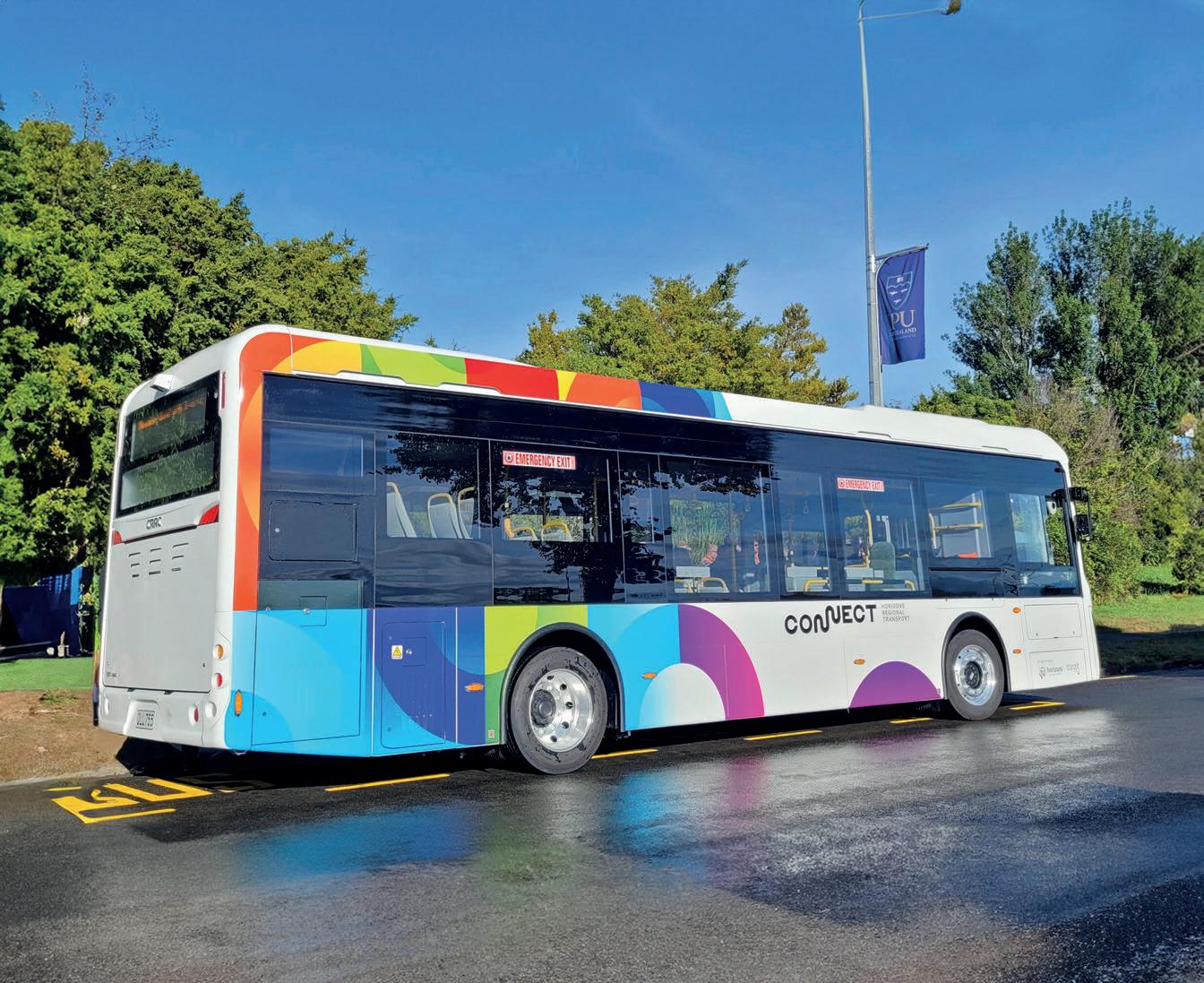
The
NZ bus industry is leading the way in the nation’s net zero transition, but what
else can be done to support this trend?
IMAGES TRANZIT GROUP
Across the ditch in New Zealand, public transport buses are leading the way in the nation’s transition to zero-emissions for tailpipe vehicles.
According to Drive Electric’s 2023 State of the Nation report, the NZ light fleet of nearly 4.4 million vehicles is only made up of 1.3 per cent battery electric powered variations and roughly two per cent plug-in hybrid electric vehicles (PHEVs).
When looking at 2023 new and used light vehicle registrations, electric and BHEV models only accounted for 11 per cent of sales in the nation. In the heavy vehicle sector, there were less than 150 electric trucks on NZ roads in 2023 at a market penetration of well below one per cent.
Amid these low numbers, the nation’s bus and coach sector
stands out. While the incoming NZ government’s removal of the Clean Car Discount and the application of Road User Charges to light vehicles from April 1 this year will continue to impact zero and low-emissions vehicle sales across the ditch in 2024 and beyond, the nation’s buses have led the way courtesy of various government commitments.
Certain policies, such as ones that require only zero-emissions public transport buses to be purchased from July 1 next year and a target to completely decarbonise public transport bus fleets by 2035, are helping the bus industry become the early adopters of clean vehicle technology in NZ.
Back in June 2019, there were only 30 battery electric buses running in NZ’s entire national fleet. By June 2021, this had grown to around 80,
Above: The bus sector is leading NZ’s zeroemissions transport transition
while in June 2023 it was sitting at just under 300 buses.
This rapid rise means the Bus and Coach Association of NZ (BCA) wouldn’t be surprised if the number doubled again between June 2023 and June 2024.
If these targets remain in place over the next 11 years, NZ’s public transport bus fleet is expected to transition to 100 per cent zero-emissions buses by 2035, while the light vehicle and heavy truck fleet will most likely lag significantly behind based on the latest forecasts.
Despite this bus-focused growth, the BCA admits there have been some challenges along the way in decarbonising NZ’s bus network, such as the higher initial upfront capital cost of battery electric vehicle technology, the absence of regulatory safety standards for
NZ’s public transport bus fleet is expected to transition to 100 per cent zeroemissions buses by 2035
electric drive-chain vehicles in NZ and questions around whether a used vehicle market for electric buses will be developed.
Coupled with the ongoing questions of how to optimise charging networks around the nation and there are still obstacles in the way for NZ’s bus industry.
The industry is leaving no stone unturned – the New Zealand Transport Agency recently commissioned and published a research report in April that explored the economics of introducing zero-emissions buses to fleets around the country. The report and associated modelling tool contained general findings that the BCA says

should be treated with caution.
However, the association’s own modelling found that prematurely retiring a recently purchased diesel buses in 2035 to buy a zero-emissions model has a higher economic and environmental cost when compared to leaving the older model in service for several more years. This results in an additional cost on the taxpayer, ratepayer and fare payer.
When looking towards the future, the NZ industry is interested to see the Australian federal government’s significant budget investment commitments to incentivise the use of clean energy technology. While nothing like this had been signalled in advance of NZ’s budget day that




was on May 30, both the BCA and NZ operators will be watching future announcements with interest as they look for a beacon of hope to help their ongoing zero-emissions transition.










MEGATRANS is Australia’s largest integrated conference and exhibition dedicated to the logistics industry. MEGATRANS is an interactive expo, reserved for companies o ering advanced technology technologies and services, grouped by their contributions
The BCA is already seeing a common ground between the Australian and New Zealand bus industries as it pushes for change
The NZ Bus and Coach Association (BCA) is delighted to partner with Prime Creative Media to up the ‘Australasian’ in the Australasian Bus & Coach (ABC) Magazine. So many of the challenges and opportunities for our industry are the same either side of the ditch, and increased collaboration and information sharing can only be a good thing. As such, the BCA is committed to strengthening our relationship with BIC and supporting and encouraging shared learnings to the benefit of our broader industries.
The landscape of our industry in NZ has changed, as it has in Australia, with increased consolidation not only of operators, but also within the supply chain. As it stands, one of the biggest challenges is the changed relationship between the bus operators and the service purchasers – central and local government. A swing from relationship-based agreements that relied on both parties doing the right thing to increasingly complex commercial arrangements has eroded trust
on both sides, while pushing up compliance costs.
Government and council decision makers (whether because they’ve rejected it or because it’s no longer being offered), are no longer receiving expert advice from the industry. That is a real problem, because it’s resulting in decisions that have negative implications for not just our industry, but also taxpayers, ratepayers and average Kiwi families. As an industry, we’re well placed to share expertise to help our clients and stakeholders better achieve their desired outcomes, and to do this effectively we’re going to need to strengthen relationships and develop better international evidence on best practice.
Like Australia, we’ve faced a battle with skills shortages across the sector. While this isn’t unique to our industry, the difficulty we’ve had recruiting and retaining urban bus drivers has been very visible to the public, with resulting service cancellations as high as 20 per cent at times, and necessitating timetable changes. Improvements to pay,
Below: The BCA is hoping for more clarity on key industry issues. Image: Emagnetic/ stock.adobe.com
funded jointly by operators, central and local government, and changes to immigration settings, combined with an amazing recruitment and onboarding effort from bus operators, saw hundreds of new drivers relocating to New Zealand and cancellation rates returning to acceptable levels.
Unfortunately, the immigration changes were recently cancelled by the incoming government, leaving real concerns within the industry about how we will maintain driver numbers at required levels. BCA is closely watching the work being undertaken by APTIA on recruitment and retention, and looks forward to opportunities to share the learnings in the NZ context.
And speaking of opportunities to share learnings, the BCA would like to extend a very warm welcome to all Australasian industry participants to attend our annual conference to share experiences, network and have some fun. The event will be held at Auckland’s Due Drop Events Centre from October 1-3. We hope to see you there!










Bus SA held another successful annual conference in May, bringing together the industry to discuss the biggest topics
The 2024 edition of state association Bus SA’s conference has seen the bus and coach industry combine in Adelaide to keep up to date with the latest sector updates.
Bus SA executive director Craig Spurr says the event, held on May 18 at the Adelaide Pavilion, included a fantastic mix of nearly 100 operators, partners and government representatives.
Starting on Friday May 17 at a welcome networking event, the conference kicked off the next day with Stephen Lucas from Bus SA
opening the conference.
From there, members of the Department for Transport and Infrastructure, as well as the shadow transport and infrastructure minister Vincent Tarzia, outlined political intentions for the industry, with Jenna Gorman from The Online Director providing the keynote address on how to ‘pitch like a pro’.
Members of Service SA and the Department for Education also presented, before a zero-emissions focus saw the likes of Bus Finance Australia, the Bus Industry Confederation, Foton Mobility and

Above:
The industry descended on Adelaide in May
Below le : The latest bus technology was on display
Below right: Attendees enjoyed a networking event
JET Charge participate in a panel discussion on an EV future.
Ian MacDonald and Roz Chivers provided updates on APTIA and BIC respectively, while Spurr outlined Bus SA’s latest movements.
The final sessions saw school bus service contracts come under the microscope before Chivers, Lucas and Julian Gurney discussed industry issues and opportunities.
“The sharing of insight, discussion and connection demonstrated the support, opportunities and strength within the bus and coach industry in SA,” Spurr told ABC

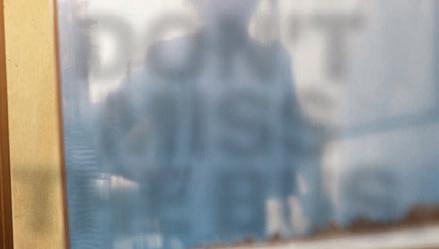









July
JULY 11-12
BusWA
APTIA BREAKFAST, BUS SHOW AND AGM
JULY 20
QBIC
REGIONAL MEMBER FORUM CHINCHILLA
JULY 27
BusVic
80TH ANNIVERSARY DINNER
SOVEREIGN ROOM, MELBOURNE CONVENTION AND EXHIBITION CENTRE
August
AUGUST 5
BusWA
REGIONAL TRIPS BEGIN
AUGUST 9
QBIC
FUTURE LEADERS LUNCHEON
AUGUST 30
BusNSW
NEXTGEN LEADERS FORUM
September
SEPTEMBER 6
BusWA
REGIONAL TRIPS END
SEPTEMBER 17-18
BIC
NATIONAL BUS AND COACH SHOW BRISBANE CONVENTION AND EXHIBITION CENTRE
October
OCTOBER 1-3
BCA
NEW ZEALAND CONFERENCE, DUE DROP EVENTS CENTRE, AUCKLAND
OCTOBER 9-10
BusNSW
2024 MEMBER CONFERENCE
OCTOBER 18-19
QBIC
CAIRNS REGIONAL MEMBER FORUM
OCTOBER 29-31
BusNSW
November
NOVEMBER 8
QBIC
REGIONAL MEMBER FORUM
NOVEMBER 14-15
BusNSW
ASSOCIATE MEMBERS SEMINAR AND PARTNER’S LUNCH
NOVEMBER 20-22
BIC
NATIONAL CONFERENCE, HOBART
December
DECEMBER 2
BusNSW
DELEGATES FORUM AND CHRISTMAS FUNCTION



TECHNICAL COMMITTEE MEETINGS AND AGM












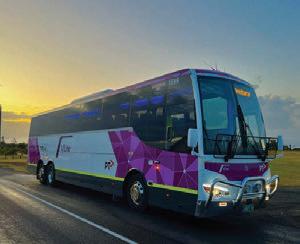





















































The June winner of ABC ’s Best Bus is a stunning shot of an Irizar Go West coach in the Western Australian sun
From freezing snow to the most barren of outback suns, ABC ’s Best Bus, sponsored by VDI Australia, has featured buses and coaches in a range of conditions. None have been as unique as the June winning photo, courtesy of Geoff Mead.
The June winner of Best Bus is one of many shots that Mead sent ABC following a recent relocation by Irizar of a Volvo/Irizar coach for WA operator Go West.
In another busy month of photo entries for Best Bus, some finalists stood out in the pack. Grant Sage
submitted two wonderful photos of Harley’s Mercedes-Benz coaches out in front of the Dandenong Ranges Botanic Park, while notorious finalist Marcus Oaten sent through another great photo of one of his fleet up on picturesque hills.
Michael from Southside Bus also sent through some beauties of buses and coaches around some unique Australian landmarks.
These finalists were all wonderful, but Mead’s photo was a clear winner. While he submitted various other great shots of the Volvo B8R/Irizar i6 out in WA, the sunset shot of the coach was a striking winner.
Above: Geoff Mead is the winner of Best Bus June with this wonderful photo
“I was out in Western Australia doing a relocation for Irizar and operator Go West when I took these photos,” Mead told ABC
For his win, Mead received a free 12-month subscription to ABC Magazine, while the winning photo is live as ABC ’s Facebook page cover photo for all of June.
If you want to be like Mead and have your best photo shown off courtesy of Best Bus, brought to you by VDI Australia, then don’t forget to send through your photos for July and the rest of 2024 via our website or by keeping an eye on our Facebook page for more details.

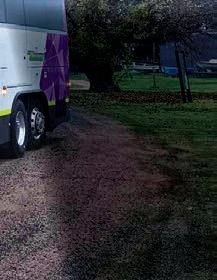











Below: A second great submission from




































2024’s Australian bus and coach deliveries continue to maintain a high level with another successful month of orders
An amazingly consistent year to date of bus and coach deliveries in Australia has been taken up a notch, with May’s deliveries leading the way in 2024.
With previous months staying consistent in the 130s, May capitalised on April’s strong numbers and surpassed the 150 mark, with 154 deliveries made in the month.
The major brands came to play in May, with Volvo once again dominating the chassis market with 49 deliveries for the month. Scania shot back up into second place, having its best month of the year so far with 40 deliveries recorded in May. Yutong slotted back to third with 20 units delivered, forming a strong top three. A er the leaders came I-Bus with 10, who stayed clear of Custom Denning, Mercedes-Benz and MAN, who all sat together with six deliveries apiece. From there, BYD had five deliveries, while BCI and BLK couldn’t be split with four each and King Long (three) wrapped up the deliveries alongside Challenger (one).
No surprises came in a busy month for the bodybuilder market, with Volgren reaching new heights with 64 deliveries made in May. It was more than three times ahead of the
The major brands came to play in May, with Volvo once again dominating the chassis market with 49 deliveries for the month.
next best Yutong (20), who snuck ahead by one to beat out BCI (19).
From there, Irizar, I-Bus and Custom Denning all recorded 10 deliveries each, with BLK (six) and Nexport (four) sticking clear of the final five brands that shared 11 units.
It was no surprise that such a major month of deliveries would mean McConnell had a productive month, with the seating giant recording 72 May deliveries. Sege impressed with 35 units to take out second spot, while Yutong rounded out the leading trio with 20 deliveries. StyleRide remained consistent with 11 deliveries, keeping one ahead of APM (10), with King Long and Fainsa finshing the market for the month with three deliveries apiece. Usual rhythms were disrupted in the May air-conditioning sector, with Coachair taking out the honours for the month ahead of the market leader in Thermo King. Coachair recorded a wonderful 50 deliveries, with Thermo King closely following
Above: Coachair took out the air-conditioning crown in May.
Image: Coachair
Turn overleaf: for comprehensive bus and coach delivery information for May. Please note all data is as supplied from manufacturers, at their discretion.
with 42. Cling-Yutong trailed the leading pair with 20 units, while Valeo (13) kept its nose ahead of both Hispacold and Songz (10 each).
MCC ticked along once again with five deliveries, with King Long (three) and Spheros (one) rounding out the month.
It was yet another month of Victoria taking out the state-based deliveries battle, with the southern state recording 54 deliveries in May. The productive month saw it fight off Queensland, who rose to the challenge and recorded 41 deliveries. NSW (28) and Western Australia (27) could barely be separated, with the pair completing a dominant group of four who led the way. Following them were South Australia (three) and the ACT (one) finalising the deliveries for the sector.
Turn overleaf for comprehensive bus and coach delivery information for May. Please note all data is as supplied from manufacturers, at their discretion.
It was no surprise that such a major month of deliveries would mean McConnell had a productive month, with the seating giant recording 72 May deliveries. Sege impressed with 35 units to take out second spot, while Yutong rounded out the leading trio with 20 deliveries. StyleRide remained consistent with 11 deliveries, keeping one ahead of APM (10), with King Long and Fainsa finshing the market for the month with three deliveries apiece.
No surprises came in a busy month for the bodybuilder market, with Volgren reaching new heights with 64 deliveries made in May. It was more than three times ahead of the next best Yutong (20), who snuck ahead by one to beat out BCI (19). From there, Irizar, I-Bus and Custom Denning all recorded 10 deliveries each, with BLK (six) and Nexport (four) sticking clear of the final five brands that shared 11 units.
Usual rhythms were disrupted in the May air-conditioning sector, with Coachair taking out the honours for the month ahead of the market leader in Thermo King. Coachair recorded a wonderful 50 deliveries, with Thermo King closely following with 42. Cling-Yutong trailed the leading pair with 20 units.
The major brands came to play in May, with Volvo once again dominating the chassis market with 49 deliveries for the month. Scania shot back up into second place, having its best month of the year so far with 40 deliveries recorded in May. Yutong slotted back to third with 20 units delivered, forming a strong top three. A er the leaders came I-Bus with 10, who stayed clear of Custom Denning, Mercedes-Benz and MAN, who all sat together with six deliveries apiece. From there, BYD had five deliveries, while BCI and BLK couldn’t be split with four each and King Long (three) wrapped up the deliveries alongside Challenger (one).






When developer Billbergia decided to create a new suburb in Sydney’s west, a bus service that is now electric became critical to its success
IMAGES BILLBERGIA
What goes into making a new community?
Adequate housing?
Top notch amenities?
For developer Billbergia, it quickly found out that transport is key when designing and introducing a new suburb to Sydney.
“We acquired the Wentworth Point site in Sydney in the early 2000s, and my father John, who founded Billbergia, always had a vision to create a new suburb,” Billbergia group director Joseph Kinsella told ABC
“As a former industrial precinct on the banks of the Parramatta River, we saw an opportunity to develop a vision for Wentworth Point. The main issue to overcome was the site’s peninsula location, with almost no social infrastructure or transport in and out of the area.
“Delivering a bridge across Homebush Bay to connect Wentworth Point to Rhodes has been a game changer. It’s effectively cut the travel distance between the suburbs from eight km to several hundred metres.”
The $63 million bridge was funded and delivered in 2016 by the private sector and handed over to the NSW government, with the bridge only being available for active and public transport. Fast forward to today and another zero-emissions bus has been recently added to the popular Baylink Shuttle fleet that Billbergia is providing in Wentworth
Point alongside local operator Punchbowl Bus Co.
“There was a huge opportunity to connect these suburbs, all through the shuttle bus that connects people to Rhodes train station,” Kinsella says.
“Providing a regular and reliable transport option has helped achieve a mode shi from car to public transport by about 13 per cent.
“We’ve been running the bus for nearly six years already and we’ve committed to operating the service as part of the final stage of our Bennelong Cove development until the delivery of the Parramatta Light Rail in 2031.”
The service started with two Optare solo buses and quickly grew once passengers began to take the bus instead of driving themselves. An immediate upgrade saw Billbergia introduce Euro 6 buses as part of the private service.
A er COVID lockdowns ended and passenger trips once again increased, Billbergia partnered with Punchbowl Bus Co to make the service a staple for Wentworth Point locals. Punchbowl has been operating in Sydney since 1947, with this latest development being a new step for the operator.
“We immediately found that both Punchbowl and us have similar values and it was an ideal partnership,” Kinsella says.
“Having regular drivers who complete these routes every day has given parents the trust to allow their kids to catch the bus to and
Above:
A third electric Baylink Shuttle bus has been added
Below:
The special shuttle service allows Wentworth Point locals to easily reach Rhodes Train Station
from school. It’s been very good for the community.”
To date, the service has completed more than five million passenger trips since Billbergia first began the run in January 2018. The partnership with Punchbowl has also seen electric buses added into the mix, with the pair recently introducing their third zero-emissions model into the fold.
With the Parramatta Light Rail still the best part of seven years away, there’s no limits as to how popular the Baylink Shuttle service can get with its new electric additions.
“The recent addition of a third electric bus has seen trips return to close to pre-COVID levels,” Kinsella says.
“It shows that people will ditch cars if they can get fast and reliable transport. The Wentworth Point design has won numerous national awards in recent years, and a large part of that is due to the Baylink Shuttle.”








